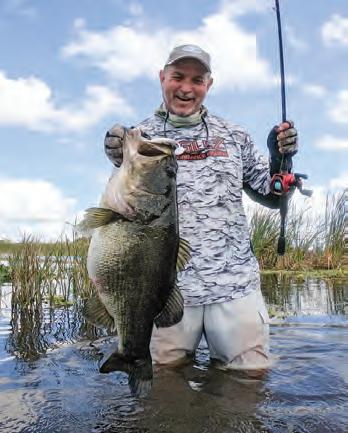






















Suzuki Marine USA has built on the success of its 2024 Stealth Line™ (“Shinobi” in Japanese) outboards with several new models that give coastal and offshore anglers even more chances to go into “Stealth Mode” on the water.
The Stealth Line™ unveiling stole the show at the 2024 Miami International Boat Show, and shortly thereafter, the family was honored with a 2024 Top Products Award from Boating Industry Magazine. Even more importantly, however, was the fact that dealers and boaters from coast to coast responded in a huge way, making Suzuki Stealth Line™ outboards the talk of the industry. Suzuki responded by adding additional models to cover an even broader range of boating and fishing applications with inline 4-cylinder 115, 150 and 200HP models and two powerful V6 250HP motors in both digitally and mechanically control versions.
Suzuki Stealth outboards feature a new all matte-black finish and matching Chrome Black graphics, for a powerful and distinctive look that compliments a range of boats, including bay boats, flats skiffs, hybrid fishing boats, and offshore center consoles. Of course, there is more to the Stealth Line™ than just good looks. Each of these models delivers the advanced technology, powerful performance, superior fuel efficiency and reliability that have made Suzuki the choice of demanding fishermen everywhere.
“We’re very excited by the great response our Stealth Line™ has received,” said Brandon Cerka, Suzuki Marine USA General Manager Sales and Service. “We listened to our dealers, boat building partners and customers, and gave them what they had been asking for — a bold new look that’s unlike anything else on the water. Now, we’re already hard at work to give them even more.”
Suzuki Marine is definitely not done yet when it comes to the Stealth Line™ family. The company is moving forward with plans to add an inline 4-cylinder 140H model very soon, as well as Stealth versions of its flagship V6 350HP integrated steering model and 300A (single prop) in the future. When these new additions join the family, coastal anglers will have eight




Throughout the month of October, the fishery in The Florida Keys will begin its autumn transition. This midway point between the drastic change of summer and winter fishing, can be unpredictable to forecast, but also provides exciting surprises during this overlap.
With cooler waters driving fish nearer to shore, reef and backcountry fishing will become more and more productive as we push into our winter fishery. The bait fish that particularly favor our shallower waters as the temperatures drop, will bring with them some of our favorite winter predators. Depending on the timeline of this seasonal change, we may begin to experience the return of sailfish and wahoo near our reef.
The anticipated temperature change of the water not only drives fish closer to shore, but is also a massive trigger for southbound migration. This is especially true for one of the ocean’s most notable vagrant; the swordfish.
Fully understanding the habits of a fish that can migrate hundreds of feet up and down the water column each day, and thousands of miles each year, can be a challenging endeavor. However, the data that has been collected on swordfish to date, has proven to be reasonably consistent.
By Capt. Quinlyn Haddon
The majority of mature swordfish, and particularly large breeding females, have been observed to spawn predominantly in the spring and summer. They favor warm waters with heavy currents for this process, which takes them as far south as the Caribbean sea.
After abandoning their millions of eggs to the currents, they will begin an incredible migration in search of feeding grounds to sustain them repeating the process all over again.
Traveling thousands of miles up the coast, as far as Newfoundland, Canada, they seemingly utilize the continental shelf has a highway.
After gorging in these northern waters throughout the summer and early autumn, they then begin their return migration through our section of the swordfish highway, opportunistically feeding along the way.
While every month in the Florida Keys provides excellent opportunity to catch swordfish, this month gives us an extra bump on prevalence of larger swordfish migrating through our waters. The same is true for November as well, but with more chances of tackling windier days, October offers a more
reliable forecast.
Catching swordfish is a great way to fill the box with a significant amount of quality meat. The yield of a single fish is more than enough to fill both your refrigerator, and when properly sealed, your freezer too. The unique flavor and texture of swordsteaks is sought after on its own, but there is always a chance that your catch is concealing an upgrade. In very rare instances, a swordfish’s meat will appear orange in color as opposed to the standard white. The quality of this meat is unparalleled, and is caused by the fish’s penchant for munching on shrimp. These special upgraded fish are referred to as pumpkin swordfish. How perfectly festive it would be to carve one of these this month.
The Florida Keys not only boasts an excellent fishery for swordfish, but can also get you there in about a 30 mile run offshore. This gives you a chance at a fish at a lifetime in half the time and cost of a west-coast grouper trip.
If this fish is on your bucket list, October in the Florida Keys presents a great opportunity to add that checkmark.
Capt. Quinlyn Haddon guides with Sweet E’nuf Charters out of Marathon, Florida Keys. Contact her at (504) 920-6342 or Captainquinlyn.com. Find her on social @captainquinlyn.

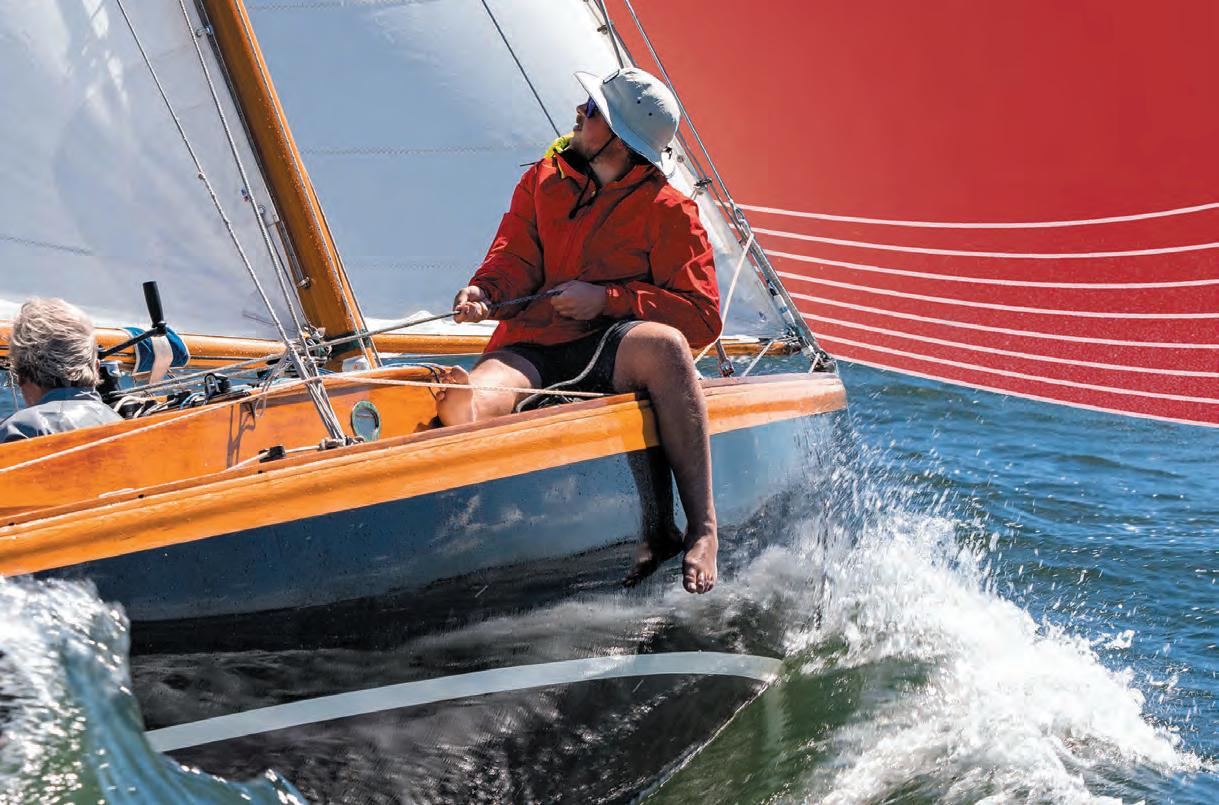


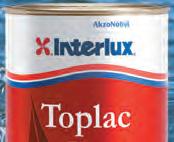

Situated riverfront and surrounded by the natural springs of King's Bay, Plantation Resort on Crystal River offers unforgettable experiences for travelers of all ages and interests to enjoy endless outdoor activities. From boating and fishing to scalloping and wildlife encounters, visitors from around the globe travel to Florida's Nature Coast to enjoy the organic assets of our dynamic destination. Reflect on the peaceful joy you'll feel while swimming alongside a manatee and her baby, the rush of adrenaline after hooking an evasive gag grouper in the shallow waters of the Gulf...there are so many memories waiting for you here! Guests will find a full-service resort with classic rooms, excellent dining, a lagoon-style pool, an Aveda spa, and a traditional golf course. Discover all there is to create your next great vacation memory.





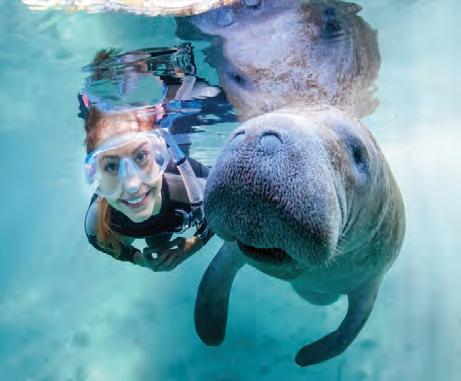
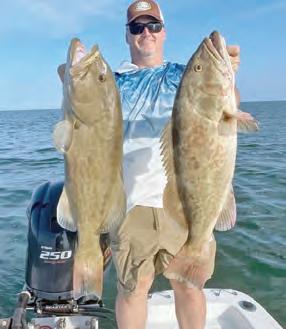


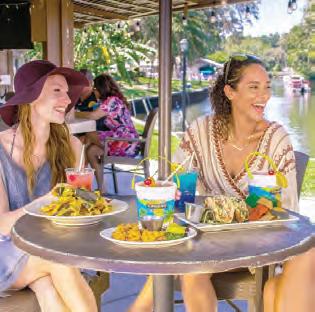


From boating and fishing to scalloping and wildlife encounters, Plantation on Crystal River is an ideal setting for travelers of all ages and interests to enjoy endless outdoor activities. To follow is just a sampling of the abundance of available outdoor pursuits.
BOATING: With more than 25,000 accessible acres of waterways, including Crystal River and Kings Bay, Plantation on Crystal River is a boater’s paradise. In addition to scenic river tours from Plantation Adventure Center & Dive Shop, kayaks, jon boats and pontoon boats can be rented by guests who want to explore on their own.


FISHING: With Central Florida fishing at its finest, Plantation on Crystal River is located alongside the Crystal River inlets and Kings Bay, just a short distance from local lakes and the Gulf of Mexico. Whether by land or by sea, anglers can cast a line for bass, grouper, snook, flounder, redfish and more. At the end of a successful day of fishing, Plantation’s chefs will be happy to prepare the fresh catch for the guest’s dining pleasure.
SCALLOPING: There is no better place to go scalloping on Florida’s Gulf Coast than Plantation on Crystal River. Taking place in shallow waters, scalloping is a fun family activity that only requires a snorkel, net and a pair of fins; no previous experience is needed. Scalloping does require a special permit, but licensed group tours and charters are available for those without a license. Scalloping season is typically July 1 to September 24.
MANATEE TOURS: Plantation on Crystal River’s Adventure Center & Dive Shop provides guests with a once-in-a-lifetime opportunity to swim and interact with threatened West Indian Manatees in the waters
of Crystal River and Kings Bay. Snorkelers will find many of the gentle creatures in the crystal-clear spring waters migrate during cooler winter months with some that stay year-round. The manatees can also be easily observed from any part of the Plantation’s expansive sea wall and gazebo point.
GOLF: Guests can tee off on the resort’s traditional Floridastyle 18-hole championship course. Surrounded by native plants and oaks, the championship course challenges guests with a number of difficult fairways and waterways, including the course’s signature No. 11 hole. The Original Golf SchoolTM at Plantation on Crystal River accommodates players of all levels, with experienced professionals offering on-course instruction, with no more than four students per professional instructor.
RESORT ACTIVITIES: Countless on-property amenities also provide entertainment to guests at Plantation on Crystal River. Highlights include a scenic, lagoon-style swimming pool overlooking the river, sand volleyball court, horseshoes, shuffleboard, oversized outdoor chess and checkers and a regulation croquet court. Nearby attractions include Three Sister Springs State Park, Crystal River Archaeological State Park, Homosassa Springs State Wildlife Park, Coastal Heritage Museum, Weeki Wachee and the Yulee Sugar Mill Ruins State Park.
Transportation is convenient with nearby international airports, including Tampa International Airport only 70 miles away, and Orlando International airport just 90 miles away.





Are you ready for some outstanding October fishing? As I write this article, we are coming to the end of a week-long rain in most of the Texas coast, and more is predicted within the next week. A nice cool front just rolled in, and water temps have dropped more than 10 degrees in some areas! We also had a mild summer compared to Texas standards. These weather patterns should shape up for an outstanding October with cooler-than-normal water temps and aggressive fish!
October is a prime time to target the big three inshore species, but I’m going to focus my time on reds and some flounder since they will be in the same areas I plan to fish. Most of my time will be spent occupying shallow flats in coves with a drain. The drain is significant if you, like me, want to add flounder to your bag. Pre-trip planning is a crucial step that cannot be overstated. It’s the key to pinpointing new areas and feeling confident about your fishing strategy; satellite imagery is the place to start.
Once you have identified a few options with open drains, not sanded in, structure within the cove, shell, and or grass, the next step is to cruise on in and look for bait. Once all of these bases have been covered, it’s time to fish.
Wading is my preferred method because it provides an extra element of structure to understand the bottom. It allows me to detect the type of bottom and subtle depth changes, giving me a deeper understanding of the fishing environment. Take a look at the satellite imagery on a low tide when a flat is dry. You can see the little depressions, let’s call them creeks, where the water empties off the flat. Sometimes, you can detect these by walking; rest assured, the fish use these to enter and exit the area.
I’ll target these areas with a topwater at times, but predominantly, I will have a paddle tail tied to the end of my line with a loop knot and a 20 or 30-lb leader. I like the paddle tail because it works well in shallow water, it can be rigged weedless, both reds and flounder love
By Capt. Michael Okruhlik
them, and they are easy to use. Cast, reel, and set the hook. A 4” Knockin Tail Lure is a great size to start with. When it comes to color selection, use what makes you happy; with the built-in tail rattle, you will get the fish’s attention with lateral line stimulation. Fish use their lateral line more to target prey than vision, and a paddle tail is the perfect tool.
Once you work your way to the drain, concentrate your cast at the edges, bends, and small washouts on the bank. Flounder will be sitting there to ambush their next meal, so a 30-lb leader will be important. The temperatures are cooling, so make sure you take a kid fishing!
Capt. Michael Okruhlik is the inventor of Knockin Tail Lures®, and the owner of www.MyCoastOutdoors.com.



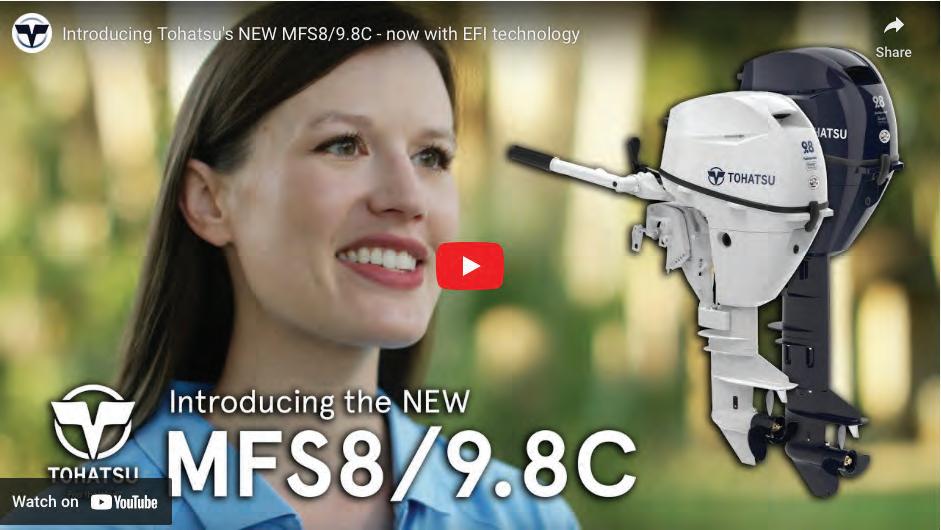
By Ben Martin, Editor in Chief
Angling is more than just catching fish—it’s a deeply rooted tradition that transcends generations, embodying a way of life, an art, and a profound source of pride. This pride isn’t merely in the size of the catch but in the entire experience, the skills refined over time, and the deep connection with nature.
Central to this pride is the mastery of technique. Whether it’s fly fishing in a mountain stream, casting a net in coastal waters, or patiently waiting with a rod and reel on a quiet lake, angling techniques require patience, practice, and a deep understanding of the environment. Anglers take pride in perfecting their skills—learning to read the water, understanding fish behavior, and selecting the right equipment. Each successful cast, cleverly tied knot, and well-chosen lure is a testament to an angler’s dedication.
The true pride in angling lies in the knowledge gained through experience. Seasoned anglers reflect on the countless hours spent mastering their sport, from how a fly lands on the water to recognizing subtle signs of fish activity. Angling is a journey of continuous learning, where each trip offers new lessons

and insights, further fueling this pride.
Angling also nurtures a deep connection with nature. Being out on the water, enveloped in tranquility, allows anglers to develop a profound respect for the environment. Pride in angling is often linked to this connection, as anglers feel a sense of responsibility toward preserving waterways and fish populations for future generations.
This respect for nature is vital to the angling tradition. Anglers often become conservation advocates, understanding that their sport’s enjoyment is tied to the environment’s health. Thus, pride in angling also includes a commitment to sustainable practices, ensuring that fish stocks are maintained and habitats remain unspoiled.
For many, angling is a tradition passed down through generations. The pride in angling is not just personal but a continuation of family or community heritage. Memories of fishing trips with parents or grandparents are cherished, and the skills learned are often passed on to the next generation. This sense of continuity creates a bond that is both personal and collective, linking individuals to their past

while forging connections with future anglers. The pride in being part of such a longstanding tradition is immense. Anglers feel a deep responsibility to honor the practices and ethics taught by their predecessors; ensuring the spirit of angling is preserved. Whether teaching a child to tie a knot, sharing stories of great catches, or passing on the secrets of a favorite fishing spot, the pride in angling is about nurturing a love for the sport that endures across time.








DRS4DNXTDRS6ANXT


You’re looking at it! Furuno’s award-winning Radar gives you clarity & target separation like no one else. Don’t take our word for it. See for yourself. Scan here, and we’ll show you!






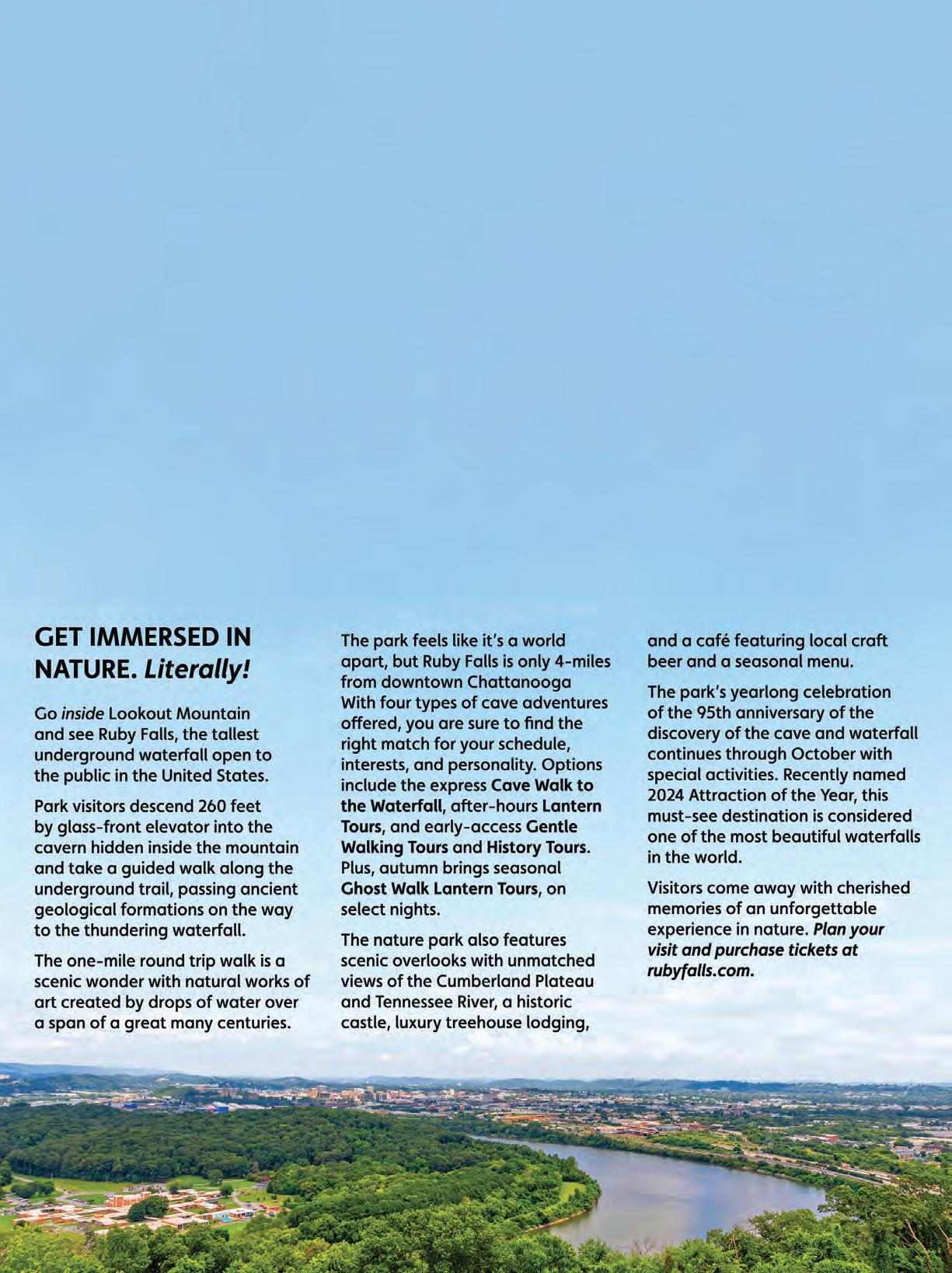





Capt. Russ Walker
Early morning fog and dropping water temperatures are a sure sign fall is near.

Yes, it’s that time of year when the big sheepshead and cool water redfish invade the local deep-water docks and structures. Both species are tough opponents, challenging even the most skilled anglers.
Sheepshead are most likely to be found around docks where subsurface pilings are covered in marine growth like oysters and limpets, and where tiny crabs live inside. Extreme submerged structures such as rock outcrops or limestone ledges are good too.
This time of year, seek the larger redfish around deep water docks where white bait and pinfish congregate for protection, becoming a plentiful quarry. Both reds and sheepsheads like to use the current that brings food naturally in their direction, possibly using the pilings as an ambush point from which to launch their attack. Look in the proximity of extended dock systems and/or rough shoreline structure; lots of the bigger fish are caught here.
Tiny crabs or sand fleas will produce great sheepshead action. Live shrimp cut in half are my next “go to” bait. Seek docks with at least eight feet of water (10’ to 14’ is ideal). Cast to the base of the pilings. Then tighten the line to feel the bite.
Small freelined pinfish or live whitebait are great for reds as the water cools thru early October.
My neighbor Jerry claims, “Redfish hate pinfish. That’s why they are such good bait.”
“Really?” I said, “Reds hate pinfish?”
“Yeah”, he said, “Pinfish eat the redfish eggs and the reds hate them.”
Now that’s some good information right there! I laughed and replied, “I did not know that!”
Oh well, to each his own.
OK, Jerry, if you say so.
I guess I’ll have to believe him because they do work well.
Cut ladyfish tightlined on the bottom is always good.
Cooling fall waters are great for many species which include pompano, mackerel, sheepsheads, trout and reds. Find some good structure or a vacant dock and give it a go.
I wish for you a most enjoyable and productive day on the water while in pursuit of your fall quarry.
Capt. Russ Walker is a USCG Masters licensed fishing guide and owner of Tide Walker Charters out of Cape Coral, FL. (239) 994-7818 www.tidewalkercharters.com
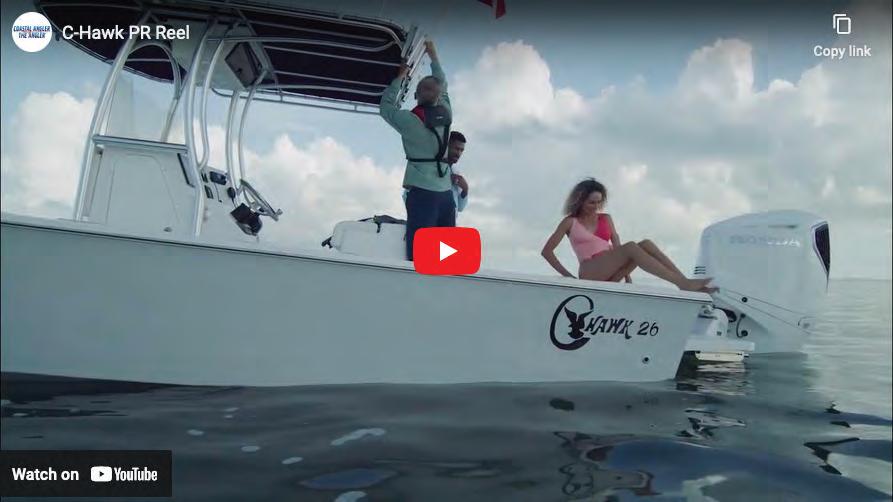

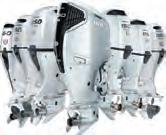




Don’t miss your chance to win the ultimate flats skiff and support a great cause! Enter the IGFA’s Ultimate Skiff Raffle and you could take home a brand-new, custom-built Chittum Skiffs 18 Mangrove Performance edition skiff (100% carbon), fully equipped and valued at $119,000. Known for crafting the most sophisticated flats skiffs on the market, Chittum Skiffs built this skiff with all-carbon construction and a sleek 12-degree hull for exceptional performance. The raffle prize comes fully rigged with a Yamaha 70 HP 4-Stroke outboard, a Power Pole Pro Series II shallow water anchor, flush-mounted GPS, sounddeadening technology for stealthy approaches, and a custom aluminum Ram-Lin trailer with Black Raptor Coating. By purchasing a raffle ticket for just $50, you not only skip the production waitlist but also directly support the IGFA’s vital conservation and youth fishing education initiatives. The IGFA partners with top scientists to research and protect iconic game fish species like roosterfish,

golden dorado, and billfish using cutting-edge DNA sampling and satellite tagging programs that drive conservation efforts around the world. Additionally, the IGFA recognizes the importance of protecting forage fish, such as baitfish, which are essential to sustaining healthy populations of game fish.
The IGFA’s youth education programs, including the Passports to Fishing initiative and global fishing clinics, teach kids the joy of fishing while promoting responsible angling and habitat conservation. By participating in this raffle, you’re helping to inspire the next generation of anglers and protect the ecosystems that game fish rely on.
The raffle ends at 11:59 pm ET on October 27, 2024, with the winner announced on October 31 during the IGFA Tommy Gifford Awards. You don’t need to be present to win, and the raffle is open to U.S. residents, 18 years or older. Every ticket purchased supports IGFA's conservation and youth education initiatives — thank you for your support!



AAs many of us have observed right now, our streams are low and our water temperatures have risen even in the higher elevations. These are not the ideal conditions to chase trout but it can be done and now more than ever the angler needs to have the fish in mind.
Trout right now are slow. Their movement is sporadic and they are trying to conserve as much energy as possible to survive. Wild trout especially need oxygen to survive; four parts per million or (PPM) in the stream or creek is the minimum. Cold water holds more oxygen so in warmer weather oxygen content is lower causing trout to become more lethargic and less active, making fishing more challenging and sometimes just not smart.
Trout feed best when water temp is between 45 and 60 degrees. Anything over 68 degrees is dangerous and can cause mortality. Trout being caught and handled properly has a survival rate of 70 to 80%, but when the fish is out of the water for around 30 seconds that drops to 60% and one minute out it goes down to 28%.
This being said, keep trout in the water, especially wild fish. Best scenario; take a look, use barbless hooks and make it a quick release. That satisfies most fly anglers. Fly selection right now in low water
By Jim Lackey



conditions should not be over thought. A small yellow or olive caddis dry fly, with a #20 or #22 pheasant tail, with or without a bead will bring fish to the net. Just have confidence in the pattern and you will have action.
Most wild fish move upstream while stocked fish, in my experience, tend to move downstream. That being said, for both wild and stocked fish, make your presentation up and across and as always try to get that good drift. I always tell my clients, this fishing is 80% presentation, 10% fly and 10% angler.
In clear water, a variety of flies can bring you success; reds and oranges are good choices. Dark colors like black, blue and violet can be better. Flashy colors like yellow and orange can work well in bright conditions while white is a good color in stained or stirred conditions.
Longer leaders are a must right now and fine tipped preferably 6X or 6.5X trout hunter fluorocarbon works best. Always take time to look around and position yourself in a spot that doesn’t require a 50-foot cast and always cast softly and accurately as you can and make your first or second cast your very best if possible.
Low water means spooky fish, real spooky fish. Trout can move 25 body lengths
per second so they are fast and they detect movement and predators from a great distance by their lateral line that runs down their midbody. They can also detect danger and food even in dingy water and can use this lateral line to communicate with other fish as well as differentiate between color and objects.
We have many miles of wild trout water in Western, North Carolina and with the renovations of the trout hatcheries on the horizon, fly fishermen may have to modify their tactics. The trout there it’s going to take patience and more strategy and maybe more understanding of our true trout.
Technical fishing will make you a better fisherman so don’t get frustrated with low numbers and smaller fish. Fooling trout and imitating his food source to get him to the fly is what this sport is all about.
Wild fish are super gamey and usually you get one opportunity at them. As a guide, and getting feedback from clients, they really enjoy the challenge so landing one is usually pretty special.
The next few years are going to be a change in our flyfishing in Western, North Carolina. We have the fish, no doubt, but it’s going to take some skill, some research, and some conservation on our part to make it successful.
GOOD FISHING!

Fall fishing offers anglers a perfect blend of cooler weather, stunning scenery, and active fish. As summer fades, the changing conditions in freshwater and saltwater environments create ideal opportunities to catch a variety of species. Whether in lakes, rivers, or coastal waters, autumn provides some of the most rewarding experiences for fishing enthusiasts.
One reason fall is excellent for fishing is the behavior of fish during this season. As water temperatures drop, fish become more active, feeding aggressively to prepare for winter. In freshwater, species like bass, trout, and walleye move into shallower waters, making them easier to target. Bass, in particular, hunt more during the fall, feeding on schools of baitfish in cooler, oxygen-rich waters.
Largemouth and smallmouth bass gravitate toward areas with abundant food sources. Anglers often succeed using lures that mimic baitfish like shad and minnows. Crankbaits, jerkbaits, and soft plastics, especially in natural prey colors, are popular choices. Fishing near structures like submerged logs, rock piles, and weed beds can increase your chances of landing a big one, as bass often use these areas as ambush points.
Trout fishing also peaks in the fall, with cooler water temperatures bringing these fish into more accessible parts of rivers and streams. Fly fishing is particularly effective during this time, as trout are more likely to strike at dry
flies and nymphs resembling the insects they feed on. In many regions, fall is also the time for spawning runs, particularly for salmon and steelhead, offering anglers a chance to catch them in large numbers amid stunning autumn scenery.
In saltwater, fall is synonymous with the migration of popular species like striped bass, bluefish, and redfish. As these fish move along coastlines, following baitfish like mullet and menhaden, they offer exciting opportunities for surf and boat fishing. The fall mullet run is a highlight for many saltwater anglers, drawing large predatory fish close to shore where they can be targeted from the beach or pier.
For those targeting striped bass, the cooler fall waters bring these fish into the shallows, making them more accessible to surfcasters and inshore anglers. Live bait like eels or bunker is often the go-to choice, but lures like topwater plugs, soft plastics, and bucktails can also be effective. The sight of a striper smashing a surface lure in the crisp autumn air is an experience that keeps many anglers coming back year after year.
Another advantage of fall fishing is the relative solitude. With many focused on hunting or other seasonal activities, fishing spots are less crowded than during the summer. This allows for a more peaceful experience, where you can fully immerse yourself in nature. The vibrant fall foliage, combined with the quieter atmosphere, creates a perfect backdrop for a day of fishing.
Overall, fall fishing offers something for every angler. Whether chasing bass in a quiet lake, casting for trout in a mountain stream, or battling gamefish along the coast, fall provides unparalleled opportunities to connect with nature and enjoy the thrill of the catch.
















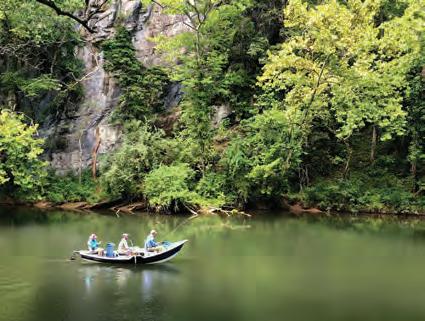








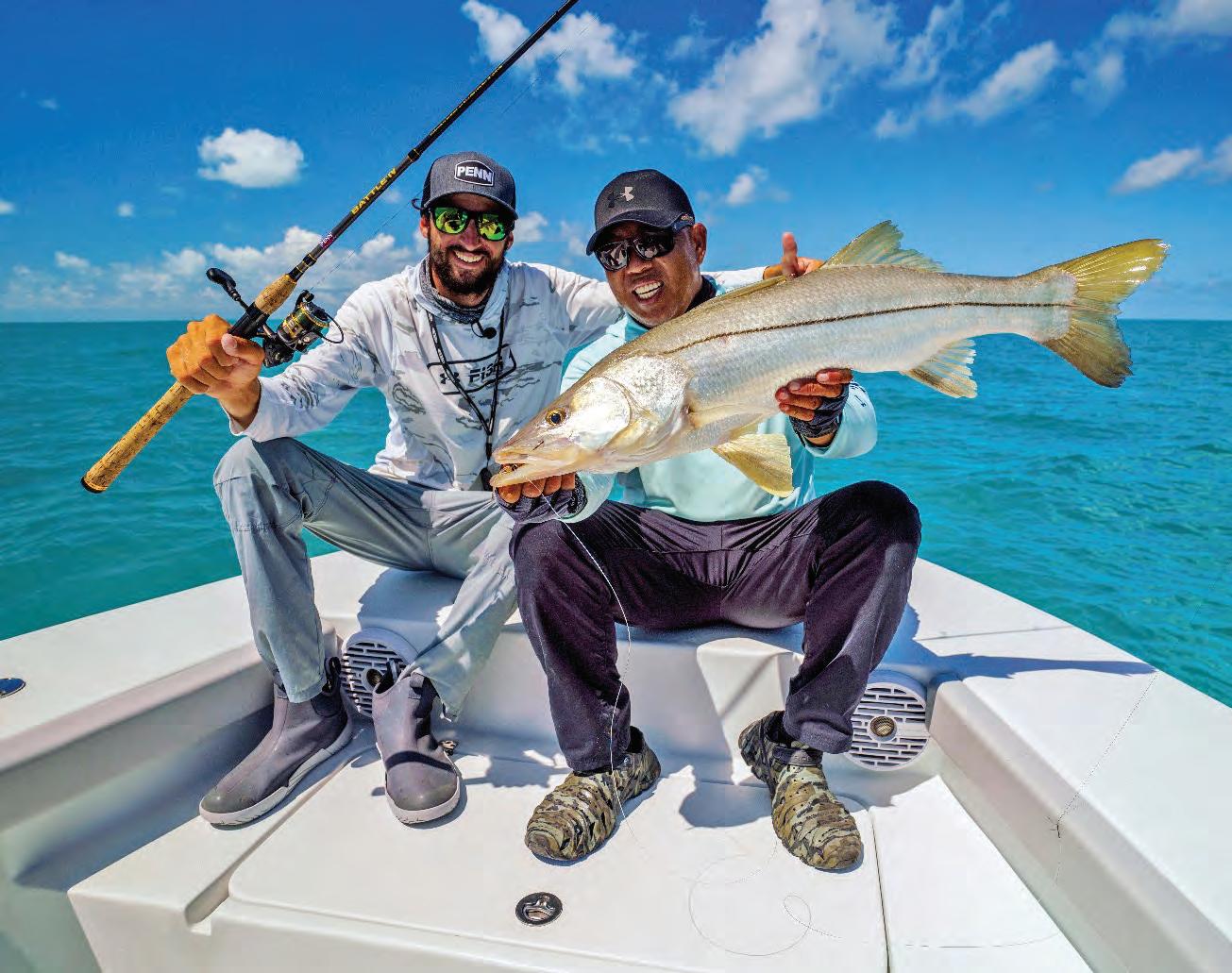
By A. deGruchy
Fall in the Florida Keys is a magical time with a lot going on both offshore and in the backcountry. The weather changes, the fish migrate and it’s especially good for those who want to target the mighty Snook. These sleek hunters are the ultimate combination of brains and brawn, making them one of the most rewarding catches for anglers. Snook are known for their powerful runs, acrobatic jumps, and ability to shake the hook at the last possible second. But that’s part of the thrill, right? Every Snook you land feels like a hard-won victory because, well, it is.
As the weather cools down (by Florida standards), Snooks start transitioning from their summer hangouts near the bridges to more sheltered waters. Look for them in mangroves, around dock pilings, and in deeper channels where they can ambush unsuspecting prey. These fish are opportunistic hunters, so if there’s bait around, you can bet Snook are nearby.
When it comes to rigging for Snook, less is more. You’ll want a medium spinning rod paired with the right reel, we usually use the PENN Authority 4500, 15-20lb braid, and 30lb
leader. Snook aren’t picky eaters, but they do have sharp gill plates that can slice through weaker lines, so using a fluorocarbon leader of about 30lbs test is a must. As for your hook, a 3/0 Mustad Demon Perfect Circle In-Line has never failed us. This is your best bet for two reasons, it tends to hook the fish in the corner of the mouth (which is perfect for catch and release), and it’s less likely to gut hook a Snook, which is important for their survival.
Snook are “foodies” and they love a good meal, whether it’s live, dead, or even


a convincing imitation. In the fall, live bait like pilchards and shrimp works wonders. If you’re more of an artificial lure fan, try soft plastics that mimic baitfish, we love the Savage Gear RTF Manic Shrimp, we’ve caught plenty of jumbos with that.
It’s important to remember that Snooks in the Florida Keys are special game fish, and there are strict regulations to ensure their populations stay healthy. If you catch one, be sure to release them quickly and do not handle them too much to protect their slime coating, which is crucial for their health. Keep them wait and revive them in the water (if it’s not a sharky area) and don’t
let go unless they start sucking on your thumb, this shows that they are ready to be released.
Catching a Snook in the Florida Keys during the fall is one of the best angling experiences you can have. These fish are tough, smart, and always up for a fight. But that’s what makes them so much fun to chase.
To book a charter, visit www.beansportfishing.com.
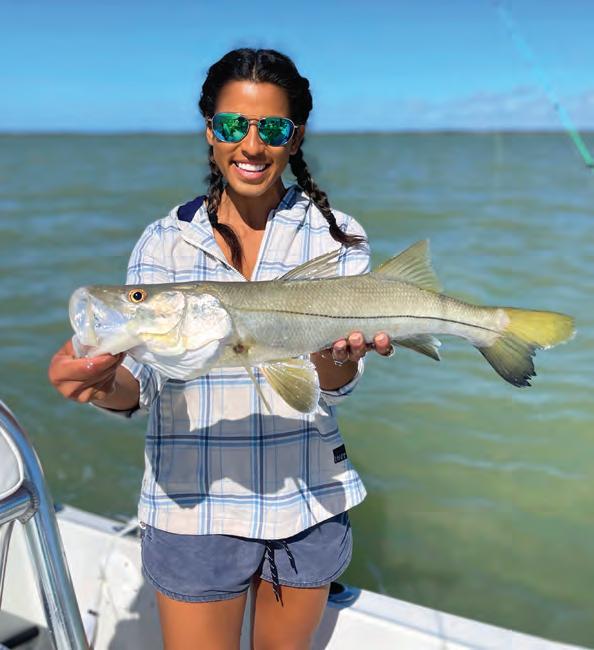
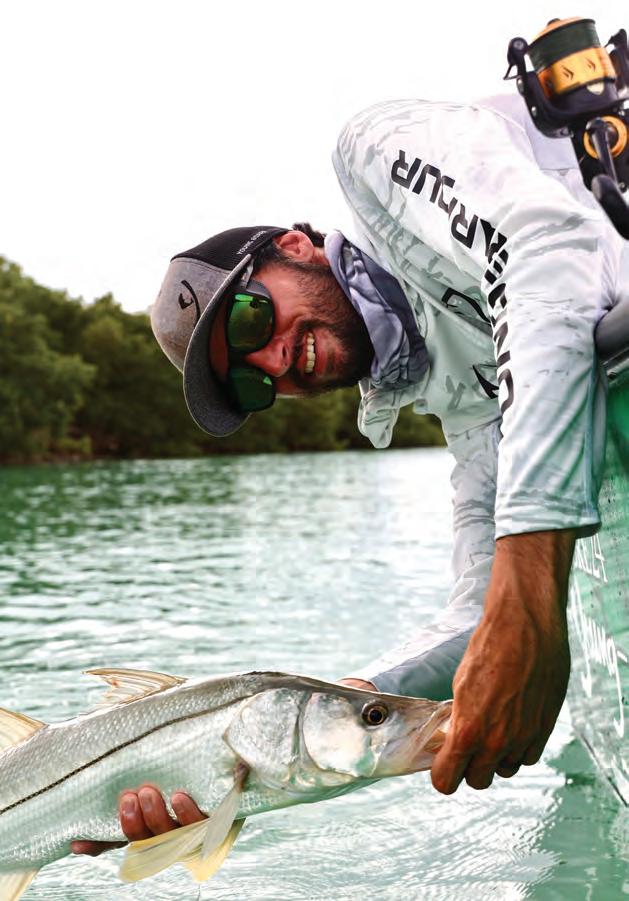
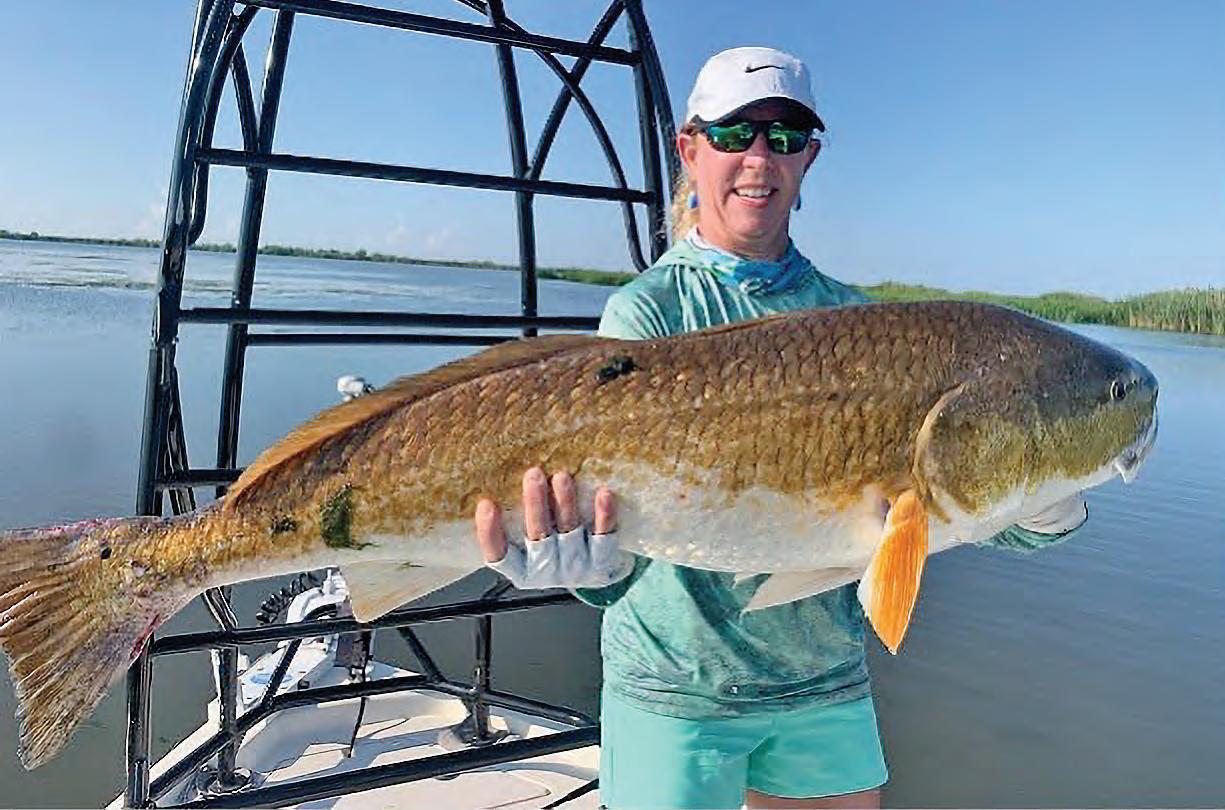


et’s dive into why proper CPR (Catch, Photo, Release) fishing is so important for the future of our fisheries. For most anglers, fishing isn’t just a hobby—it’s a lifestyle, one we hope to pass down to future generations. But that requires us to be good stewards of the waters and ensure the fish we release have the best chance of survival.
Here’s how to give your catch the best shot at thriving post-release, focusing on five key areas of fish health:
1. Gills: Gills are vital for fish to breathe, and damage here can be fatal. Always use in-line circle hooks and avoid holding fish by the gills. If a fish is deeply hooked, it’s better to cut the line.
2. Skin: Fish skin acts as a barrier against bacteria and toxins. Pre-wet your hands, deck, and landing nets before touching a fish to protect its slime layer. Avoid using cloths or bringing a fish in too quickly to prevent damage.
3. Jaw: A damaged jaw can prevent a fish from feeding. Never hold large fish by the jaw alone, and avoid using barbed hooks for catch-and-release.
4. Internal Organs: Fish are not built for vertical positioning. Always support larger fish horizontally to prevent damage to their internal organs.
5. Eyes: Fish rely heavily on their vision. Be cautious not to scrape or touch their eyes during handling.
Perfecting Your Fish Photo: Capturing that perfect fish photo is satisfying, but it’s important to do it safely. Always face the fish and yourself toward the light, and be mindful of what’s in the background. For solo anglers, plan ahead with a camera mount and practice using a timer or video mode.
Catch, Photo, and Release Tools: Having the right gear can make a big difference:
• Fish grips for securing the fish
• Needle-nose pliers for easy hook removal
• De-hooker to minimize contact
• Waterproof phone case to protect your gear
• Camera mount for solo photos
Strong Fishing
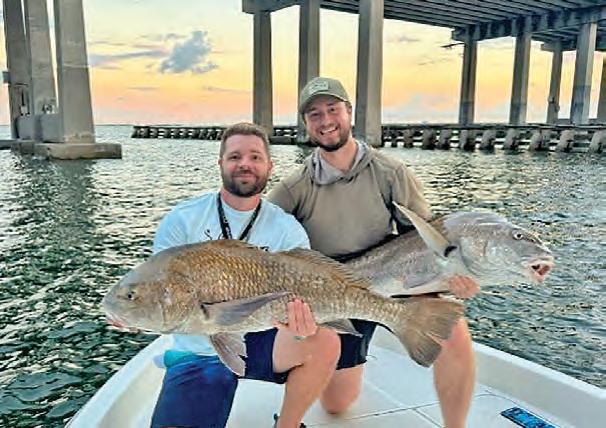
Being a responsible angler means practicing and promoting proper catch, photo, and release techniques. Let’s all work together to protect our fisheries for future generations, educating others along the way. And remember—if you see someone holding a fish incorrectly, kindly guide them, don’t shame them. We’re all here to enjoy the sport and preserve it for years to come.
The Salt Strong Fishing Club is an inspiration for inshore saltwater anglers. Salt Strong chapters are located from Texas to Florida to the Carolinas and offer club members and their guests the opportunity to meet local anglers, learn from informative speakers, participate in conservation activities, and win awesome giveaways.
Visit SaltStrong.com and SaltStrongAlliance.com to learn more.

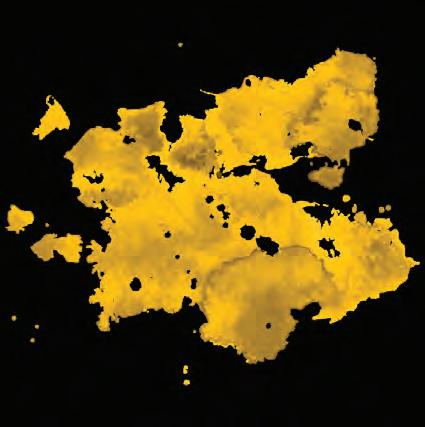








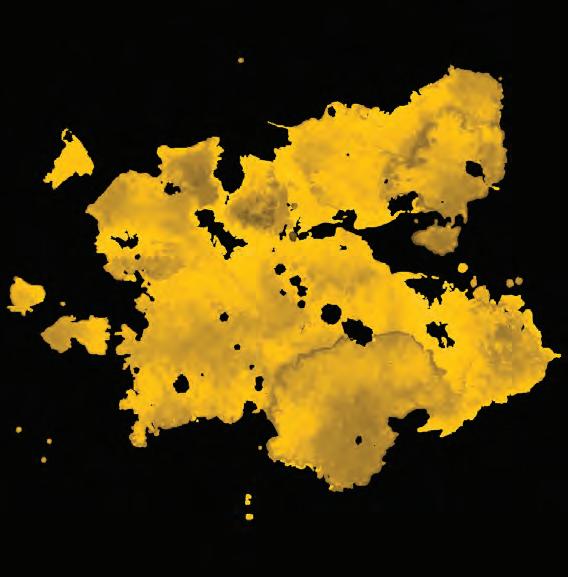

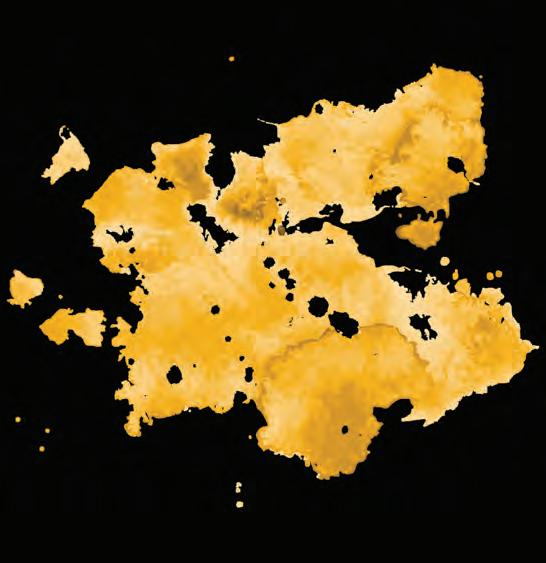
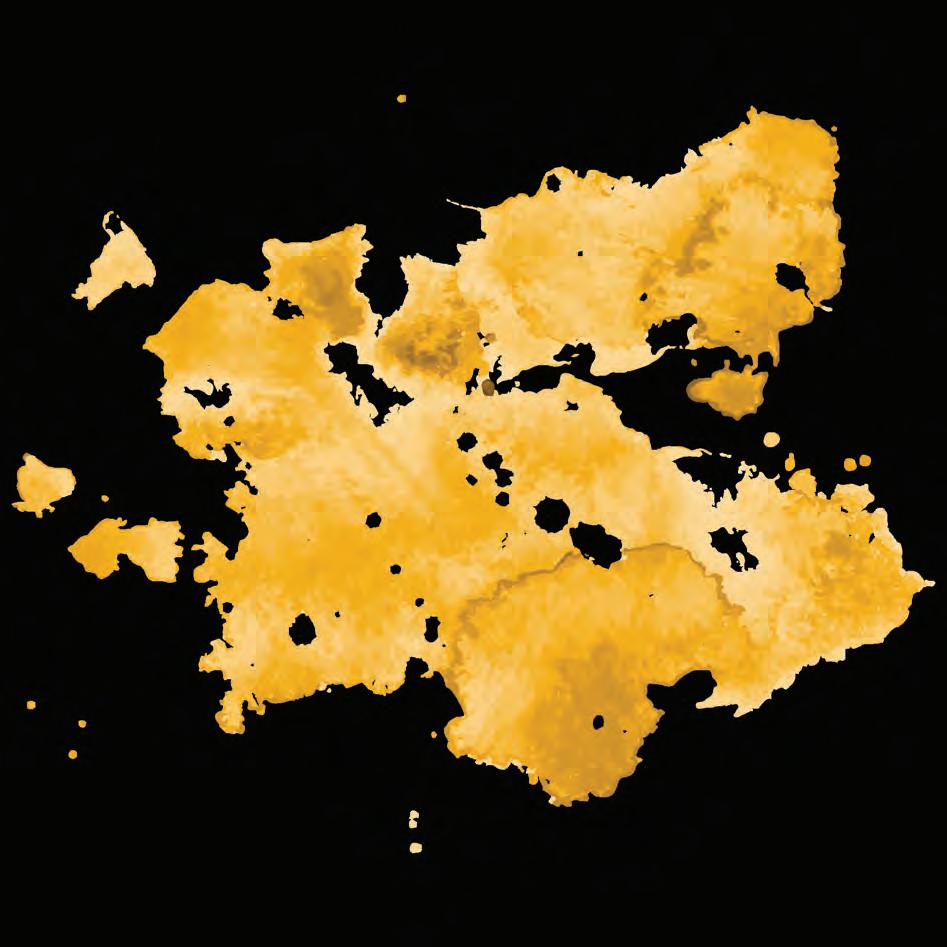





By Grayson Louis

The mullet run is a captivating natural event that draws anglers, wildlife enthusiasts, and photographers to the southeastern United States each fall. This annual migration of mullet, a resilient and abundant fish species, plays a crucial role in the marine ecosystem and holds cultural and economic significance for coastal communities.
As temperatures begin to drop in September and October, millions of mullet— both striped mullet (Mugil cephalus) and white mullet (Mugil curema)—begin their
southward migration along the Atlantic coast and the Gulf of Mexico. They are driven by an instinctual need to spawn in the warmer waters near the Florida Keys. This migration, which can last several weeks, often features schools of mullet stretching for miles along the coastline.
The mullet run is vital for the species’ survival, ensuring the continuation of their population. Mullet are prolific breeders, releasing eggs in open water, which are fertilized and hatch into larvae. These larvae then drift with the currents back to estuaries,
where they find a rich, sheltered environment to grow and mature before starting their own migration journeys.
For predators, the mullet run is a feast. Large schools of mullet attract a diverse array of marine life, including gamefish like tarpon, snook, and redfish, as well as apex predators like sharks. Birds of prey, such as ospreys and pelicans, also join in, diving into the schools to catch their fill. This abundance of food creates a feeding frenzy that is both a boon for wildlife and a breathtaking spectacle for observers. Anglers eagerly anticipate the mullet run,
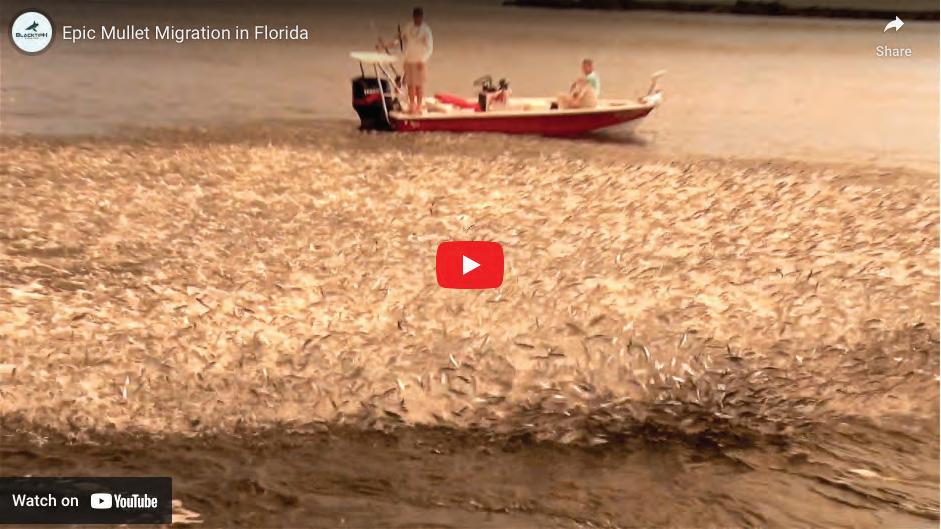

as it offers a unique opportunity to catch trophy-sized fish that are otherwise elusive. Many anglers plan their entire year around this event, knowing that the presence of so many mullet will increase their chances of hooking a prized tarpon or snook. The mullet run also supports local economies, as the influx of tourists and fishing enthusiasts boosts business for bait shops, boat rentals, and coastal restaurants.
Beyond its ecological and economic importance, the mullet run holds cultural significance in the regions it touches. Coastal
communities have long celebrated the mullet run with festivals, fishing tournaments, and other events that bring people together to appreciate the sea’s bounty. These traditions underscore the deep connection between humans and the marine environment, highlighting the importance of conservation efforts to protect this natural treasure for future generations.
Despite their resilience, mullet populations face threats from habitat loss, and pollution. Conservation measures, such as fishing regulations and the protection of estuarine
habitats, are essential to ensuring the continued success of the mullet run. By preserving the conditions that allow this migration to thrive, we safeguard a vital food source for many species and maintain a cultural and economic asset for coastal communities.
The mullet run is more than just a migration; it is a reminder of the intricate and interconnected web of life in our oceans. As we marvel at the sight of countless fish moving as one, we are also called to recognize our role in preserving the delicate balance of the marine ecosystem
By TRACY PATTERSON
In the last decade, fishing has seen a significant transformation with the rise of female anglers. Once a male-dominated activity, more women are now not only participating but also excelling, reshaping the fishing community and breaking down stereotypes.
According to the Recreational Boating & Fishing Foundation (RBFF), the number of female anglers in the U.S. has increased by nearly 20% over the past ten years. In 2020, around 17 million women fished, making up nearly 40% of all anglers. This shift reflects broader changes in societal attitudes toward women in traditionally male-dominated activities.
Female anglers are challenging longstanding stereotypes. Fishing, often seen as a rugged, solitary pursuit for men, is proving to be a universal activity. Women are demonstrating that anyone can enjoy fishing,
regardless of gender.
Social media has been crucial in this shift. Platforms like Instagram and YouTube have allowed female anglers to share their experiences and successes with a global audience. Influential anglers like April Vokey and Kristine Fischer are showing that women can excel in all aspects of the sport, encouraging more women to try fishing.
The fishing industry has responded by creating more inclusive products and marketing campaigns. Companies now design gear specifically tailored to women, such as fishing rods with smaller grips and clothing lines that blend functionality with style. Brands are also increasingly featuring women in their advertising, making fishing more accessible and inclusive.
The rise of female anglers has also had positive social and environmental impacts.

Women who fish often involve their families, leading to an increase in family fishing trips and fostering a love for the outdoors in the next generation. Additionally, women are playing a key role in conservation efforts, advocating for sustainable fishing practices and protecting aquatic habitats.

Organizations like Casting for Recovery are empowering women through fishing, offering programs that combine the sport with wellness and community-building activities. These initiatives introduce more women to fishing while promoting physical and mental wellbeing.
As more women continue to enter the sport, they inspire further innovation and inclusivity within the fishing community. The rise of female anglers is a testament to the power of diversity and the enduring appeal of fishing as a sport for everyone.






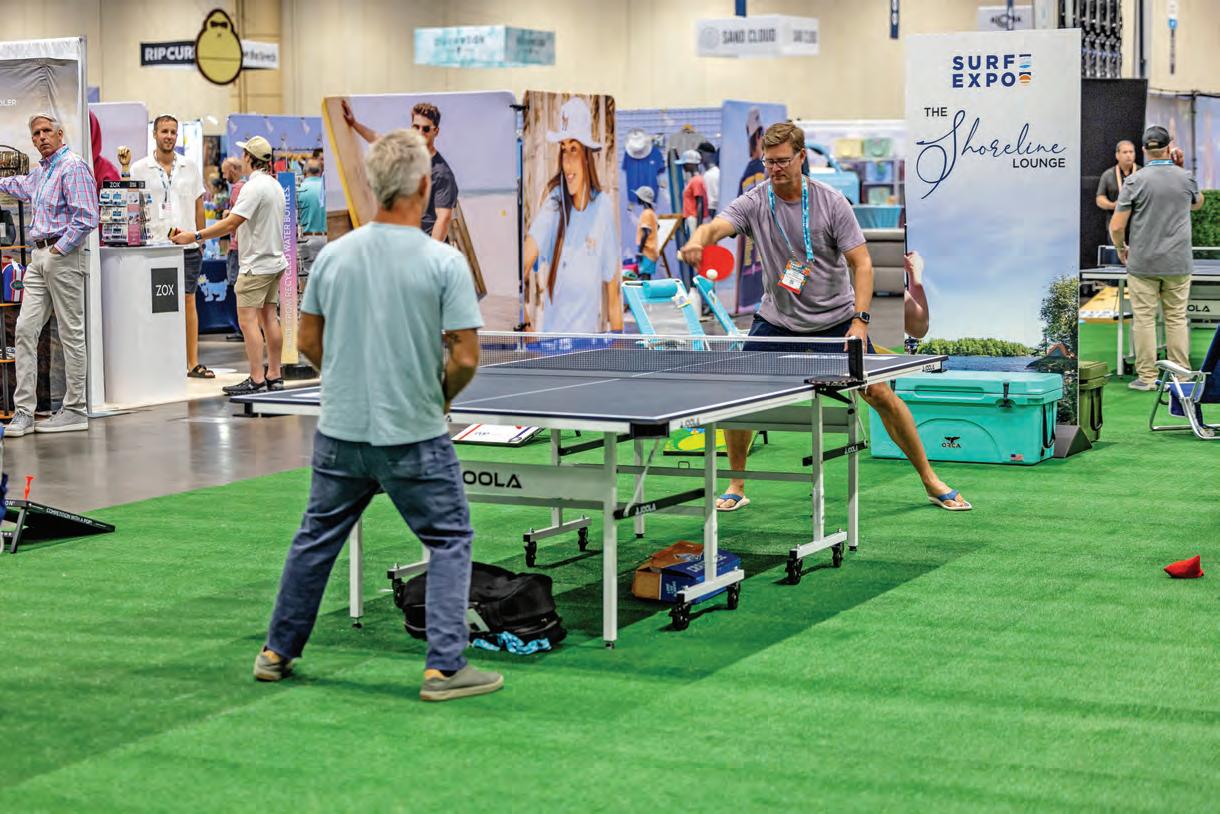
Spremier watersports and coastal lifestyle tradeshow, will return to the Orange County Convention Center in Orlando, Florida, from January 8-10, 2025. The event will feature an expansive selection of exhibiting brands, a full lineup of events, and great networking opportunities. “We had an exceptional September show, which has only heightened our excitement for what’s to come in January,” said Surf Expo Show Director Roy Turner. “From major brands to emerging start-ups, retailers can connect with key players and explore the latest innovations. We are excited for the January show floor to be filled with energy as brands showcase their products to retailers,” adds Turner.

JANUARY 8-10, 2025
footwear, outerwear, and watersports hardgoods as well as games and accessories for enthusiasts to transition from a day on the water to stretching out on land. It caters to businesses involved in outdoor activities and recreation, creating valuable crossover opportunities for buyers and manufacturers.
Surf Expo is the go-to market for watersports and outdoor retailers to explore the newest styles and trends, offering the opportunity to stock your shelves with the latest in marine related products, top surf brands, hard goods, apparel, footwear, swimwear, accessories, gifts, and souvenirs. Retailers can discover the newest brands and products related to fishing, surfing, paddling, hiking, camping, wake surfing, tubing, or simply enjoying the sun. Surf Expo provides everything needed for customers who are passionate about the waterman and outdoor lifestyle.
“Consumers today are looking for unique and new products. Surf Expo allowed us to shop and locate lot of interesting finds to bring some freshness into our store so we can give our shoppers a reason to keep coming back.” says Steve Green of High Mountain Sports.
The January 2025 show will feature brands across multiple categories including the Shoreline category. Shoreline at Surf Expo features brands that specialize in inshore and offshore apparel and accessory products; sportswear, technical
Surf Expo fosters community, commerce, and connections. The atmosphere at the event fosters the ideal environment for direct engagement between retailers and brands. Green added, “We love the vibe at Surf Expo. It’s easy to get serious business done with key players, but not so serious that you can’t enjoy happy hours and events at the show too. We were able to connect with multiple sales managers and met several founders at the September show.”
Surf Expo continues to support and enhance growth and innovation within the watersports and coastal lifestyle industries. In January, Surf Expo will feature a full schedule including daily fashion shows, retailer learning labs, networking events including happy hours and parties as well as the 2025 Florida Shape Off.
For more information about the show, or to register to attend January 8-10, 2025 in Orlando, visit www.surfexpo.com.










Tim Barefoot
It’s kinda like the old Byrds song “For everything, there is a season…”
It could not be more true for the month of October, and the season for the shrimp, white shrimp to be specific. The (white) shrimp will start to “march” from the sounds towards the inlets and into the ocean. They will do this march against the current towards the ocean at night mainly. This is the very reason we fish and catch shrimp at night. With the new LED lights, you can produce hundreds and even thousands of lumens with very low wattage/battery drain.


Do your own research, but I’ve found the Illumisea brand to be cost effective and super bright. When you fire up the lights, you will attract the shrimp. When you have the shrimp, you have the fish. Pretty simple concept. I’m not saying the fish will not eat mullets, menhaden, cigar minnows and sardines, or whatever is prevalent in your location, but what I am saying is they will key in on the shrimp and become pretty darn picky if there are a lot of shrimp present. They don’t have to be huge shrimp, just a shrimp. I have seen really nice trout eating (keying on) the very small ones at times. If you can find the large 15-18 count then you’re good to go for whatever you want to catch. We call these “Tarpon Selects”. Everything in the water will eat these, from the average sized



trout and drum to the largest snook and tarpon. Period. It’s the king of all baits, and October is the month to make the most of it.
For more information, visit barefootcatsandtackle.com and check out his YouTube channel.









The Xtreme Power Assist Steering is engineered to bring the smooth, easy control of electric power-assisted steering to a wide range of popular boats, including pontoons, runabouts, RIBS, aluminum fishing boats and center consoles. This is an affordable, easy-to- install solution that offers a more enjoyable driving experience.
This system differs vastly from competitive “electric helm” systems on the market, because it does not increase the load on the mechanical
steering helm or cable. Once this system is installed, the mechanical steering cable now only turns the power assist unit, while the electric steering actuator actually turns the engine load. This ensures reliable long-term performance in real-world, on-the-water conditions.
• Significantly reduced steering effort provides a car-like driving experience for mechanically steered boats.
• Engineered to fit a wide range of single
• Integrates with any existing SeaStar rack or rotary cable steering system, so there is no need to install new steering to take advantage of this new technology.
• Designed as a self-contained, plug-andplay system which easily mounts to all major outboard brands and integrates with the boat’s existing mechanical steering in less than 1 hour.
• Built in Fail-safe System automatically reverts to mechanical steering in the event of a system failure.


The Florida Fish and Wildlife Conservation Commission (FWC) has celebrated a major achievement with its TrophyCatch program reaching 15,000 approved trophy bass catches. Launched in 2012, TrophyCatch invites anglers to submit photos and documentation of bass weighing 8 pounds or more. The program aims to enhance understanding and conservation of Florida’s bass population while rewarding participants for their impressive catches.
Tom Graef, Director of FWC’s Division of Freshwater Fisheries Management, highlighted the milestone as a testament to both the


enthusiasm of Florida’s anglers and the state’s exceptional fishing opportunities. He noted that the data collected is crucial for ongoing conservation and management efforts.
The program’s success reflects Florida’s status as a premier bass fishing destination. It gathers valuable data on bass sizes, weights, and locations, which aids in managing and sustaining the state’s fish populations. Industry partners such as Bass Pro Shops, Mercury Marine, and Phoenix Bass Boats have been
instrumental in supporting TrophyCatch, rewarding anglers and contributing to freshwater management.
TrophyCatch is not just a promotional program; it’s a citizen-science initiative that helps in the conservation of trophy bass fishing. Anglers interested in participating and being included in this year’s boat drawing can visit TrophyCatch.com for more information and to register.
The milestone of 15,000 trophy catches underscores the program’s success and the strong community of anglers dedicated to preserving Florida’s bass fishing heritage.
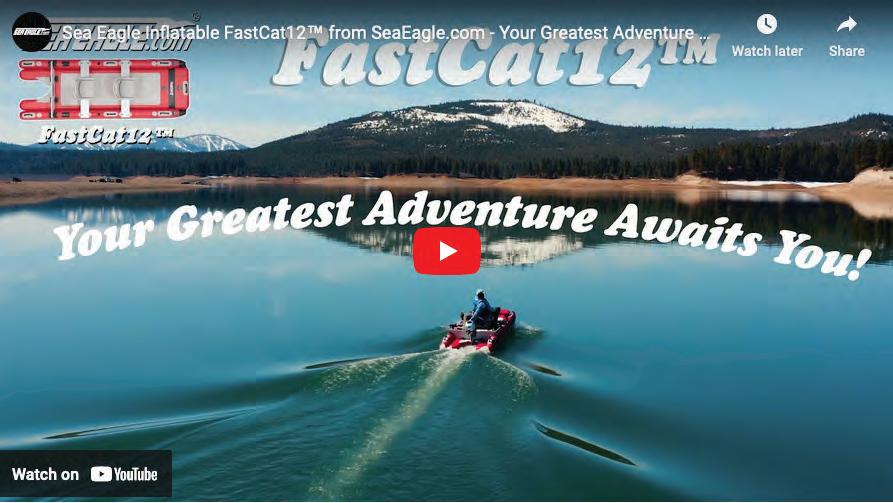
The innovative Sea Eagle® FastCat™ 12 inflatable catamaran is like no other. This 12’10” boat inflates in minutes to 15psi making it rock solid. At 4’ 8” wide, it is extremely stable for standing and casting. Easily get on and off from shore, a dock or the water. Takes an electric or gas motor up to 6 hp and reaches speeds up to 15 mph. Perfect for bays, lakes, ponds, and more.
• 12’10” x 4’8” Inflated
• 57” x 27” x 16” Deflated
• Weighs94 lb. (Hull & Transom)
• 6 hp Capacity • 1-2 Person Capacity
• 4 Separate Air Chambers
• 8” Side Chambers • 6” Floor Chamber


To support their mission to restore and protect Florida’s waters, Captains For Clean Water (CFCW) is raffling off a one-of-a-kind custom 2024 Hell’s Bay Professional Skiff, along with a literal boatload of gear from partner brands Orvis, YETI and Costa Del Mar.
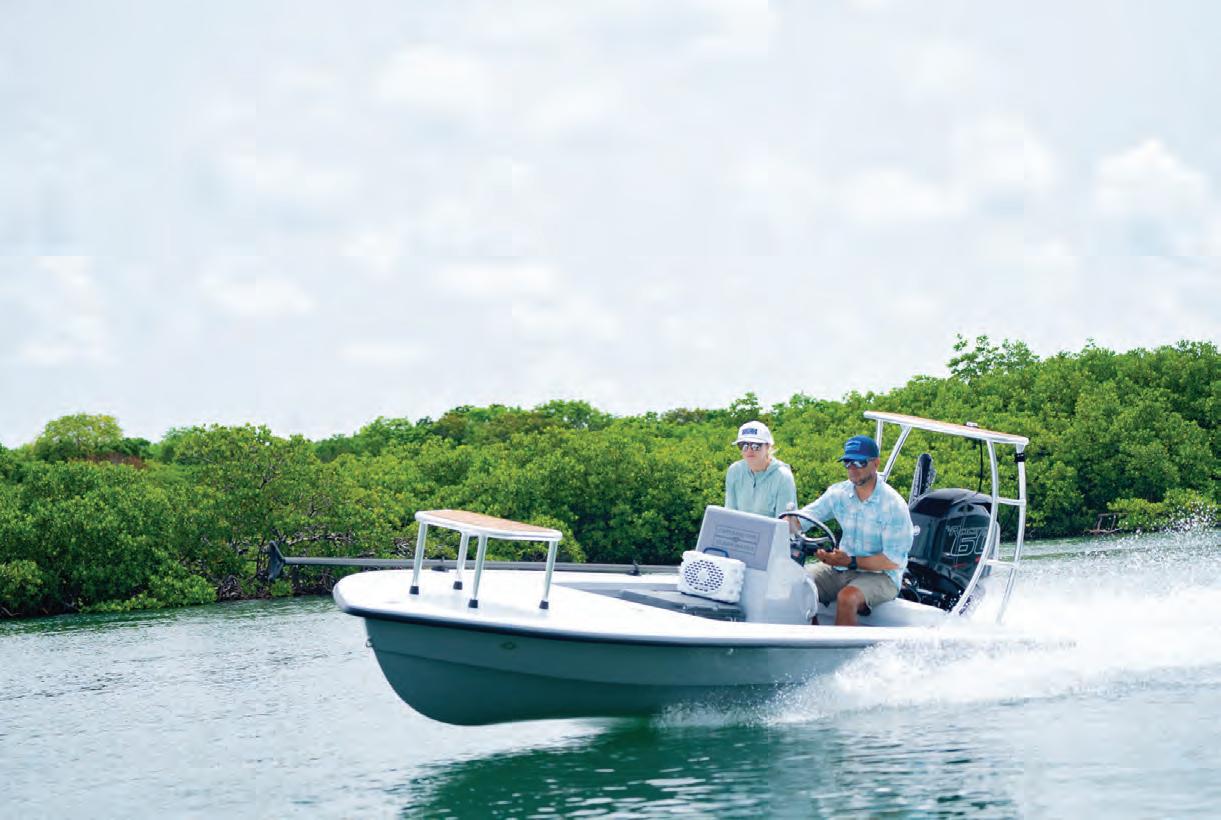

2024 CUSTOM HELL’S BAY PROFESSIONAL 17.8’ SKIFF
MERCURY 60R • SEADEK FLOOR KIT • RAM-LIN TRAILER • SIMRAD DISPLAY
• POWER POLE 6FT. PRO • TH MARINE
JACK PLATE • STIFFY GUIDE PUSH POLE
• 4 ORVIS HELIOS FLYRODS • $1K COSTA
GIFT CARD • ORVIS & YETI GEAR Purchase
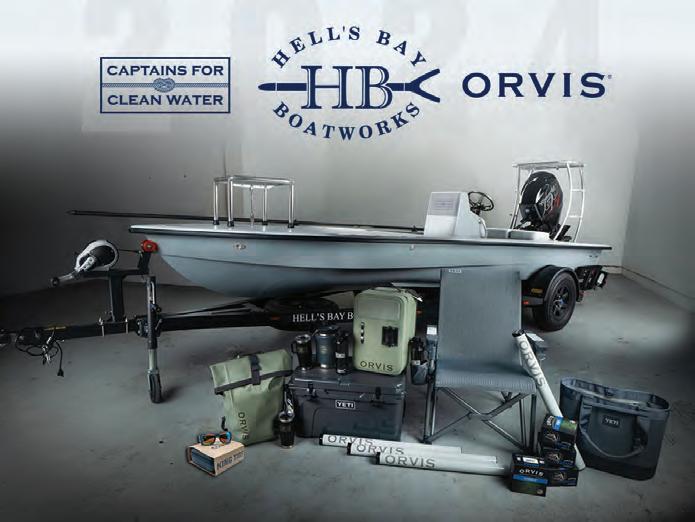

To support their mission to restore and protect Florida's waters, Captains For Clean Water (CFCW) is raffling off a one-of-a-kind boat custom crafted by Hell's Bay Boatworks of Titusville, Florida, along with a literal boatload of gear from partner brands Orvis, YETI and Costa Del Mar.
This year's skiff is a Hell's Bay Professional 17.8, the ultimate shallow water technical poling skiff specifically designed for the pursuit of fish in the most challenging shallow water conditions. Carefully engineered for poling the flats with stealth, this skiff is outfitted with a Mercury 60R Motor, T-H Marine Atlas hydraulic Jack Plate Micro Jacker, custom SeaDek floor kit, Ram-Lin aluminum trailer, Simrad NSS9 evo3S multifunction display, a Power Pole 6ft. Pro Series and a Stiffy Guide Series - Graphite 22’ Push Pole.
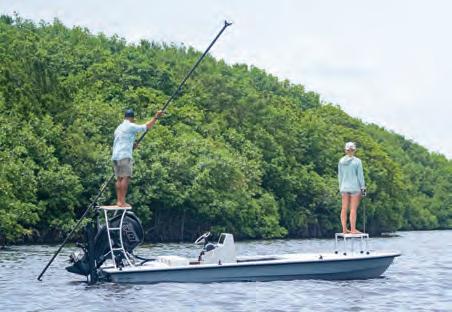
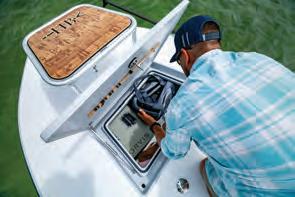
But what really makes this boat unique are the special touches done in collaboration with Orvis. Sporting a multi-tone grey color combination and custom cork SeaDek floor kit, this boat's look and feel was inspired by the Orvis Helios line of fly rods—of which there are four included with the package.
Captains For Clean Water is a Florida-based 501(c)3 grassroots nonprofit on a mission to restore and protect aquatic ecosystems for the use and enjoyment of all. Founded in 2016 by fishing guides, CFCW has united the outdoor industry, business community, and concerned citizens at the forefront of the fight for clean water—the lifeblood of Florida’s economy and $85.9 billion tourism industry.
"In 2016, we started as a couple of fishing guides who were fed up

with Florida’s poor water management practices—the toxic discharges from Lake Okeechobee that were poisoning the coasts, starving the Everglades, and devastating the estuaries our livelihoods depended on. And we were convinced that if everyone just knew about these issues, they would’ve been fixed long ago. The solution was known through a plan called Everglades Restoration, but progress had been delayed for decades due to lack of political will and public awareness,” said Capt. Daniel Andrews, Captains For Clean Water’s Co-Founder and Executive Director. “We never set out to start an organization, but as we peeled back the layers, we realized we were neck-deep in a ‘David-versusGoliath’ fight to save our waters. We’ve kept our roots within the guide community and effectively engaged concerned citizens, business communities, outdoor brands, and anglers across the country. As a result, progress is happening at a record pace as more people than ever get involved in the fight for clean water, but we still have a long way to go and we need your help."
Supporters can purchase tickets for a chance to win now through December 31, 2024. Every ticket purchase supports CFCW’s mission to protect and restore Florida’s water resources for the use and enjoyment of all. A winner will be drawn at random on January 12, 2025 at Backyard Social in Fort Myers.







Speed up your clean up! Removes salt, corrosion inhibitor, and surfactant.
Safe to use on metals, glass, paint, ceramic coatings, wax, vinyl wraps, SeaDek, electronics, screens, reels, trailers, etc.
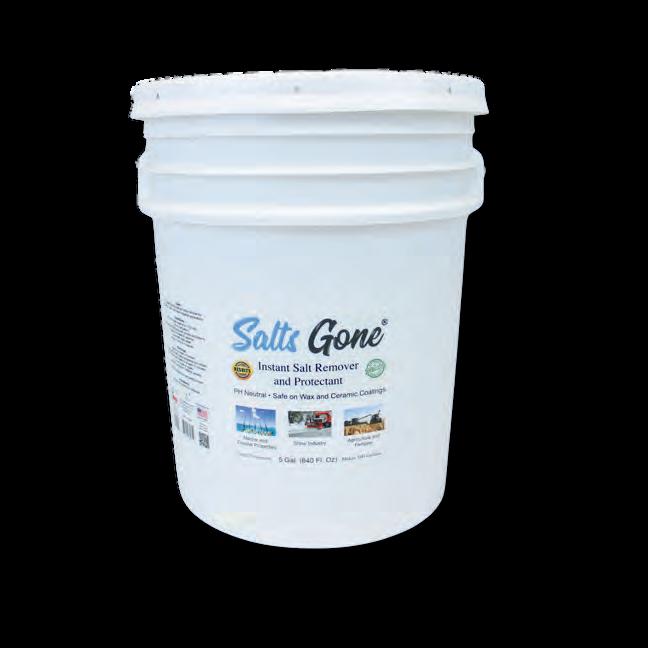





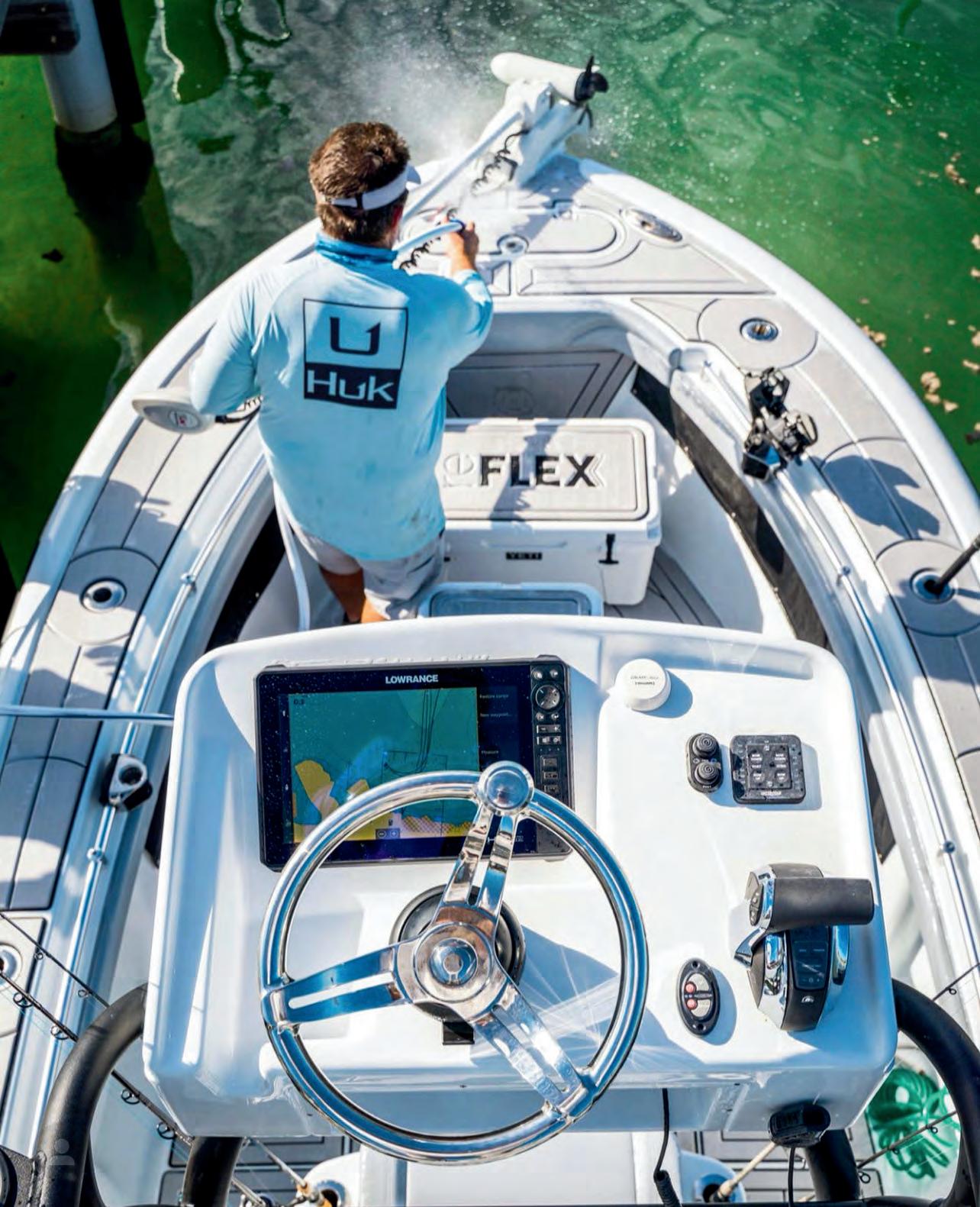
See it in action!



Stone crab season in Florida is a muchanticipated event, drawing both commercial and recreational anglers eager to harvest these prized crustaceans. The season typically runs from October 15 to May 1, a period carefully regulated to ensure the sustainability of the stone crab population. With its delicious, sweet meat, the stone crab is a sought-after delicacy, and understanding the rules, techniques, traps, and bait is crucial for a successful and responsible harvest.
Many anglers opt to dive for stone crabs, using snorkeling or scuba gear to search for crabs in their natural habitats. Stone crabs typically reside in rocky or muddy bottoms, hiding in crevices or burrows. Divers must exercise caution, as the crabs’ strong claws can deliver a painful pinch.
The Florida Fish and Wildlife Conservation Commission (FWC) enforces strict regulations to protect stone crab populations. Only the claw of the stone crab may be harvested, as the crabs can regenerate lost limbs. When retrieving a crab, it is essential to handle it gently to avoid injuring the creature or causing unnecessary stress.
The claw should be twisted off carefully, applying steady pressure at the joint until the claw releases.
It is illegal to remove both claws from a single crab, and the harvested claw must meet a minimum size requirement of 2-7/8 inches, measured from the tip of the claw to the first joint. Crabs must be returned to the water immediately after the claw is removed. Improper removal can result in the death of the crab, which is both unethical and a violation of FWC regulations.
The FWC also limits the number of traps allowed. Recreational anglers can use up to five traps, while commercial fishers are permitted more, provided they hold the appropriate licenses. Each trap must be clearly marked with the owner’s information, including a buoy with the angler’s name and address. Additionally, traps must be checked at least once every five days to ensure that crabs are not kept for too long, which could lead to their death or reduce their ability to regenerate claws.
Stone crab traps are specially designed to capture these crustaceans without causing
harm. The traps are typically rectangular and made of plastic or wood, with openings that allow crabs to enter but make it difficult for them to escape. Inside, the trap is baited with food that attracts the crabs, such as fish heads, chicken necks, or other types of seafood. The scent of the bait lures the crabs into the trap, where they remain until the trap is retrieved.
When setting traps, location is key. Stone crabs are often found in shallow waters near jetties, docks, mangroves, or rocky shorelines. Traps should be placed in areas where crabs are known to feed, ideally on a sandy or muddy bottom where the crabs feel safe.
Stone crab season in Florida is more than just an opportunity to enjoy a delicious seafood delicacy; it is a tradition steeped in respect for the environment and the species. By following the FWC’s rules and regulations, using humane harvesting techniques, and selecting the right traps and bait, anglers can enjoy a successful and sustainable stone crab season. Understanding these essential aspects of stone crab harvesting will enhance your experience and contribute to the ongoing preservation of this valuable resource.

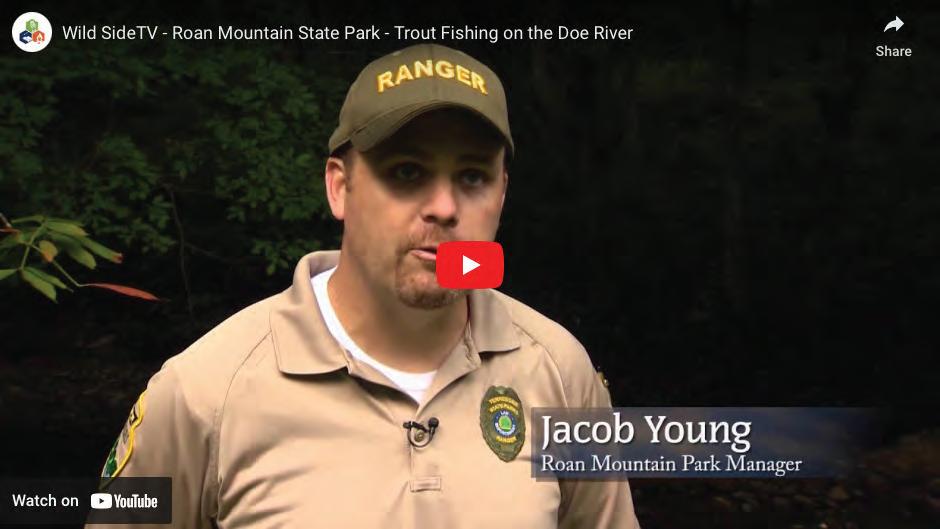
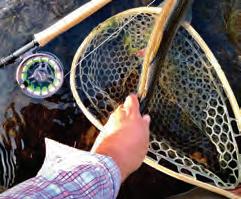
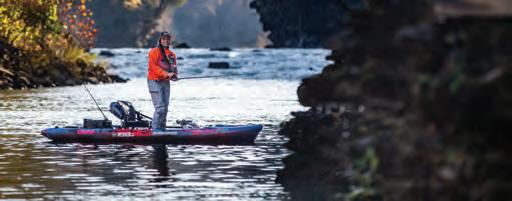

When it comes to freshwater fishing, Tennessee has an embarrassment of riches. From massive rivers and reservoirs to small ponds and high-elevation trout streams, the state is home to incredible fishing opportunities. Tennessee State Parks are excellent base camps for on-the-water adventures. They offer amenities for lodging or camping, and many of them are right on the water, with unparalleled access to some of the best fisheries in the nation.
Here are a few great Tennessee State Park fishing destinations:
• ROAN MOUNTAIN STATE PARK: Fed from elevations of around 6,000 feet, the Doe River runs clear and cold through the center of Roan Mountain State Park. Its tributaries are home to healthy year-round populations of native brook trout and both wild and stocked rainbows and browns.
The 2,000-acre park is dominated by hardwood forests and rugged ridgelines. It is a beautiful place to be, whether you’re casting flies or just camping and going for a hike.
• HARRISON BAY STATE PARK: Just outside of Chattanooga, Harrison Bay is a 1,200-acre park with 40 miles of shoreline on Chickamauga Lake. If you’re a bass angler, you know “The Chick’s” reputation as a big-bass factory. It is ranked among the best largemouth fisheries in the world.
The massive reservoir is also a great fishery for smallmouth bass, striped bass, crappie, walleye and big Tennessee River catfish.
• ROCK ISLAND STATE PARK: North of McMinnville, Rock Island is an 883-acre state park on the headwaters of Center Hill Lake, where the Caney Fork, Collins and Rocky rivers meet. These rivers and the lake itself are some of the best fisheries in this part of the world for “The Fish of 10,000 casts.” If the mighty muskellunge is on your hit list, this is a good place to chase one.
The park is also a fantastic place to catch walleye when the rivers fill up with spawning walleye in early spring. There’s plenty of bank space to fish from, and it’s a great area for kayaks, canoes and boats.
• NORRIS DAM STATE PARK: A short drive from Knoxville, Norris Dam State Park is 4,000 acres on Norris Lake. The lake is renowned for excellent smallmouth bass fishing as well as good fishing for largemouth bass, catfish, striped bass and walleye.
If that isn’t enough get you excited, the Clinch River downstream of Norris Dam is one of the best tailwater trout fisheries in the Southeast.
These four Tennessee State Parks are just the tip of the iceberg. With fishing as a primary draw to more than 40 state parks in the volunteer state, you’ll need to do some research to plan your next adventure. For information, visit tnstateparks.com.










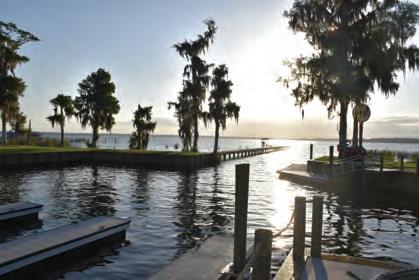
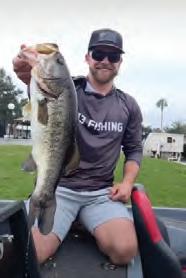
Outdoor Adventure Retreats brings together the best of camping, fishing and outdoor adventures across our four unique locations: Wilderness Cove, Crescent Fish Camp, Wanee Lake & Cotton Patch Landing.
Whether you're casting a line on the St. Johns River, exploring the Pamlico River, or soaking in the peaceful surroundings while flyfishing on the Green River, our retreats offer something for every angler.
Our expert staff are here to ensure you have everything you need — from bait and tackle to boat fuel and guided fishing experiences. Visit OutdoorAdventureRetreats.com for more information!



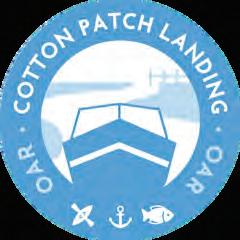
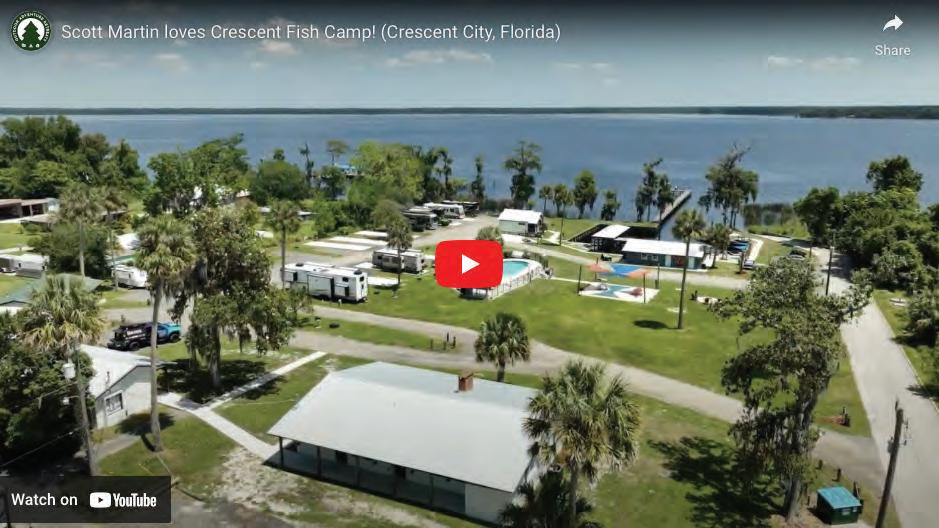
For anglers, there’s nothing quite like the thrill of a big catch in a pristine natural setting. Whether you’re after largemouth bass, red drum, or even just a peaceful day on the water, Outdoor Adventure Retreats offers a variety of fishing experiences at four premier locations across the Southeast.
Located on the tranquil shores of Crescent Lake in Central Florida, Crescent Fish Camp is a dream destination for anglers. The lake is part of the St. Johns River system, known for its abundant bass, crappie and bluegill. The camp features a fully equipped marina, bait & tackle shop, and even guided fishing trips for those looking to make the most of their time on the water. After a day of fishing, guests can relax in a cozy cottage or tiny home and enjoy the pool with views of the lake.
Cotton Patch Landing offers unparalleled access to the Pamlico River and Blount’s Creek, prime waters for catching speckled trout, red drum and flounder. The waterfront cabins provide the perfect base for your fishing adventure, and the camp store has everything you need, from bait & tackle to snacks and drinks for your day on the water. Onsite boat storage facilities, boat fuel and

a full-service marina make Cotton Patch Landing the go-to destination for an Eastern Carolina fishing adventure.

Situated along the Green River, Wilderness Cove is a perfect spot for those who enjoy both flyfishing and adventure. The river is home to a variety of fish species, and the camp’s fly shop has everything you need to gear up for a successful day. Wilderness Cove is also adjacent to the Green River Gamelands, making it an ideal spot for those looking to combine fishing with other outdoor activities in Western NC.
While known for its beautiful golf course, Wanee Lake also offers fantastic fishing opportunities in its private lake. Stocked with bass, catfish and bream, the lake is a hidden gem for anglers. After a morning of fishing, guests can enjoy a round of golf or relax by the pool. The clubhouse is perfect for a quick bite and a cold beer before heading back out on the water.
Outdoor Adventure Retreats prides itself on offering more than just a place to stay—guests enjoy a complete outdoor experience. With a variety of accommodations, from RV sites and glamping tents to cottages and vacation homes, and a range of amenities designed with anglers in mind, your next fishing trip can be as relaxing or as adventurous as you want it to be.
So whether you’re planning a solo trip, a family vacation, or a group outing, you’re invited to discover the best fishing and outdoor experiences in the Southeast at Outdoor Adventure Retreats. Book your stay today and start planning your next great adventure on the water!



By CAM Staff
Anglers have long observed that fish activity is influenced by the lunar cycle, giving rise to what are now known as lunar tables. These tables serve as invaluable tools for predicting when fish are most likely to be active and feeding. But how do lunar phases affect fishing, and how can anglers use lunar tables to their advantage?
A lunar table provides information on the moon’s phase and its position relative to the Earth and the sun. These factors significantly affect tides, which in turn influence fish behavior, especially in coastal and tidal waters. The moon’s gravitational pull creates tides, and as the water moves, it stirs up nutrients and prey, encouraging fish to feed.
Beyond tides, fish have a circadian rhythm that governs their daily activities, including eating and resting. Many species, especially saltwater fish, also follow a lunar rhythm directly influenced by the moon’s phases. Fish tend to be most active during the new moon and full moon phases, when tidal movements are more pronounced and feeding conditions improve.
Lunar or solunar tables break down the moon’s influence into specific time slots for optimal fishing, categorizing them into “major”
and “minor” feeding periods. Major periods occur when the moon is directly overhead or underfoot, while minor periods happen when
1. New Moon: During the new moon, when the moon is between the Earth and the sun, strong “spring tides” occur due to the combined gravitational forces of the sun and moon. These heightened tides trigger more active feeding, particularly inshore and near tidal flats.
2. Full Moon: Like the new moon, the full moon also causes strong spring tides. Fish, especially predators, are more active at night during this phase, taking advantage of the increased light for hunting.
3. First and Last Quarter: These phases generate weaker “neap tides,” with less pronounced tidal changes. Fishing can still be productive, but fish activity is generally reduced compared to the new and full moon phases.
the moon is on the horizon. Major periods generally result in higher fish activity, although both are useful for timing fishing trips.
Most lunar tables are simple to read, often color-coded for clarity. High fish activity times may be highlighted in green or red, while less favorable periods might appear in blue or gray. By planning your fishing trips around these prime times, you can increase your chances of success.
However, lunar tables are just one factor among many. Weather, water temperature, and the habits of specific fish species also play crucial roles. For instance, overcast conditions during a full moon can reduce visibility, hindering feeding, while high winds or changing barometric pressure may alter fish behavior.
Lunar tables are a valuable tool for anglers seeking to maximize their success. Understanding the moon’s phases and their effect on fish behavior, especially during new and full moon phases, can help you plan fishing trips during peak activity periods. Although they don’t guarantee a catch, combining lunar tables with local knowledge and weather conditions can significantly enhance your chances of a productive day on the water.
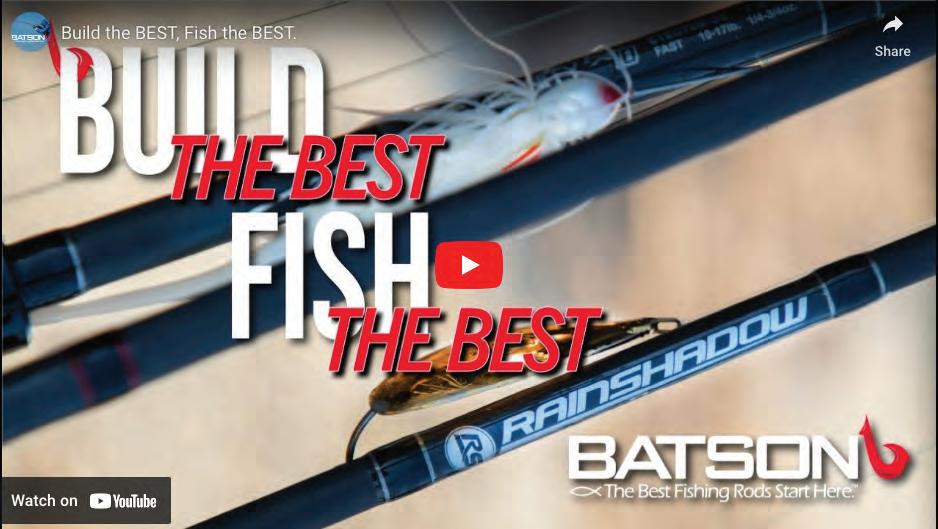

For the past 25 years Batson has provided the best line up of rod blanks and components in the industry. Now we’re offering direct access to our network of professional rod builders that make it easy to outfit your boat with rods built to fish your way. Click this ad to visit us online, browse rod blank and component options, and get in contact with the best fishing rod creators in the business.


Forty-nine reservoirs stretch across the Tennessee Valley like a string of pearls. And for those who love to fish, those lakes are just as valuable. Whether it’s bass, crappie, walleye, or catfish, whether for sport, food, or just fun, you can find world-class lake fishing only hours away from any spot in the Tennessee Valley. From more than 11,000 miles of shoreline or while floating on more than 700,000 acres of water, residents and visitors will quickly learn why this area is considered one of the best fishing destinations in the U.S. and, some would say, the world.
Fishing from the shore can be restful and rewarding—and anyone can do it. All you need is a little intel about how to find a spot where the fish might be biting. Here are a few tips for successful shore fishing from the Tennessee Wildlife Resources Agency:
• Fish are often swimming near the shore in the spring and fall. If you’re fishing from the shore in the heat of summer, do it in the evening or early morning—or even after dark.
• Fish near-unique features such as docks, logs, trees, rocks, or rocky areas; aquatic vegetation; or places where creeks enter the water.
• When fishing in moving water, look at the surface for boils and breaks—this means there is some underwater structure blocking the current, which could be the perfect hiding place for fish.
• Begin fishing (casting) close and parallel to the bank, then work your way outward (fan casting) toward deeper water.
• If you don’t get any bites, try switching baits. If this doesn’t work, move to another hole.
• Wear polarized sunglasses so you’ll be able to see fish as well as submerged objects more clearly. (Your eyes will also be protected from the tackle.)
If you love outdoor sports—boating, hunting, fishing—and the natural world, or if you just like to observe wildlife, build birdhouses, maintain a bird feeder or are just curious about the critters in your backyard, the Tennessee Wildlife Resources Agency is here to help enrich your outdoor experience. Visit us at www.tn.gov/twra/




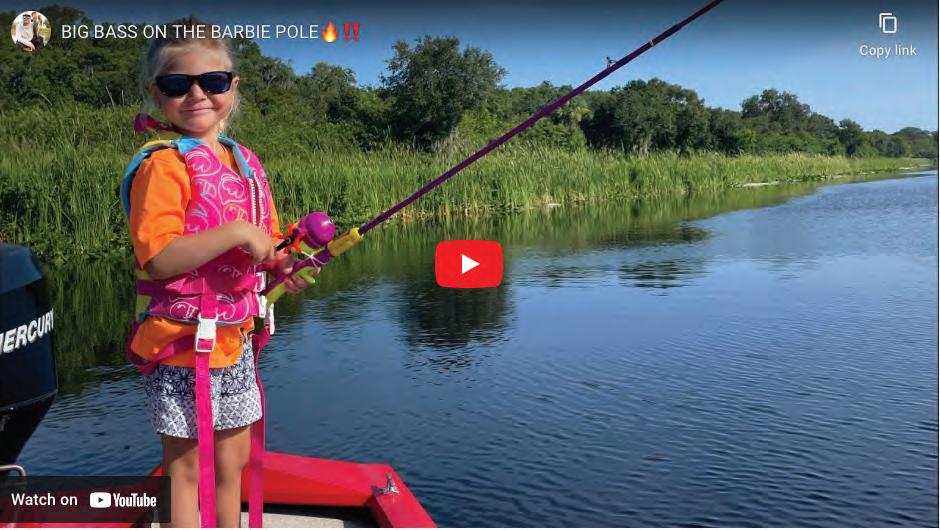
I’ve spoken with and interviewed many anglers during my career as an outdoor writer. One of my favorite questions is,
“Do you remember the first fish that you caught?” It’s amazing to me how many anglers do in fact remember the very first fish that they ever caught. Most recall every element involved in that first catch. All seem to instinctively smile when recounting the event. It’s a fond memory, one that glistens each time it’s retold.
This right of passage can occur at any age. For me I was four years old standing beside a small pond with a cane pole, red and white bobber and baited hook in the water, with my dad kneeling beside me. I remember that it was a sunny day and that we were both smiling.
As the bobber went under my dad said, “Catch him, Son!” and I instinctively raised the cane pole to bring the brim to my dad’s reach. We put the fish in a metal bucket full of water and I stared at it and observed it the entire ride home. I remember how proud my dad was as he shared the story of my catch with the rest of our family, and thus began a lifetime of catches and smiles and fond memories and a sense of pride and accomplishment. A lifetime of those wonderful elements thanks to my dad.
Teach a kid to fish. They’ll likely never forget you, and you’ll likely change their life for the better.

By John Mosley


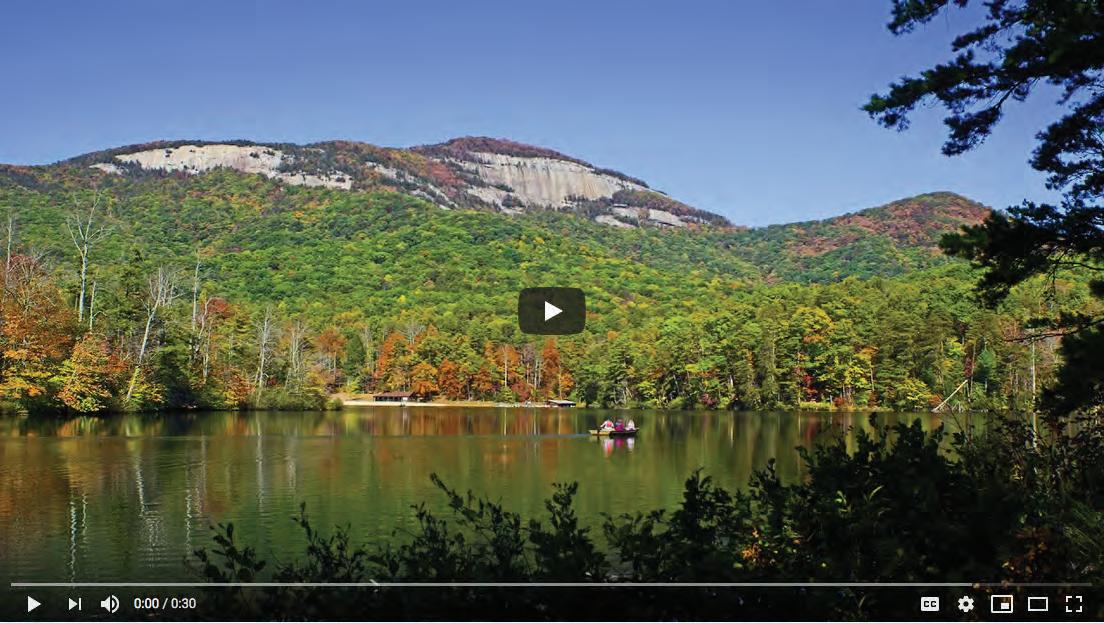
You don’t need an invitation to have fun in Upcountry South Carolina: Come kayak crys-tal blue lakes, hike to rushing waterfalls, dig into local cuisine, attend family oriented events and breathe fresh mountain air. But when you hold a South Carolina fishing license, it feels like an official ticket to enjoy the great outdoors.
Fish bite year-round in the lakes, rivers and streams of Upcountry South Carolina, which is located in the state’s northwest corner in the foothills of the Blue Ridge Mountains. Devils Fork State Park in Salem is a great place to access Lake Jocassee, which holds state records for rainbow trout, brown trout, redeye bass, smallmouth bass, spotted bass and yellow perch. Or try your luck at Lake Hartwell, at Lake Hartwell State Park in Fair Play and Sadlers Creek State Park in Anderson, three-time host of the Bassmaster Classic.


The Chattooga River boasts healthy wild trout populations and is also regularly stocked by Oconee County’s Walhalla State Fish Hatchery. The Whitewater River above Lower White-water Falls is another great option for wild trout. Lake Keowee, at Keowee-Toxaway State Park in Pickens County, swims with largemouth, smallmouth and spotted bass, crappie, bluegill, yel-low perch, catfish, brown and rainbow trout.
Pick up everything you need—including advice— at local fly shops or book a guided fish-ing trip. Sam Jones, of Jocassee Charters, puts anglers on trophy trout. Buster Green’s Guide Ser-vice reels in stripers, hybrids and bass on Hartwell and Keowee. Chattooga
River Fly Shop leads fly fishing trips on the Chattooga and Chauga rivers.
Even if you don’t fish, you can still get on the water. Jocassee Lake Tours offers tours of the lake and of Jocassee Gorges, which National Geographic called a “destination of a Lifetime.” Some amazing spots can only be reached by boat. Several tours are offered, so you can learn from a naturalist while riding on a pontoon or paddle a kayak through coves and under waterfalls.
Prefer to captain your own boat? There are several rental companies, including Tri-County Boat Rental, on Keowee, Jocassee, Hartwell and other lakes.
If you’d rather be under the water, Jocassee is a world-renowned freshwater diving desti-nation that boasts visibility of more than 50 feet at depth. Lake Jocassee Dive Shop offers lessons and guided trips to see “The Wall,” where a section of mountain was blasted to build the dam, or a 40-foot swim-through wooden sailboat.
From fishing to boating, hiking to camping, biking to bird watching and more, the Up-country’s state parks are a great place to play. Dip into the swimming hole at Oconee State Park. Hike to the tops of Pinnacle and Table Rock mountains at Table Rock State Park. Explore the 13,000-acre Mountain Bridge Wilderness Area at Caesars Head State Park. Or create your own adventure at any of the Upcountry’s 13 state parks.
UpcountrySC.com to learn more.







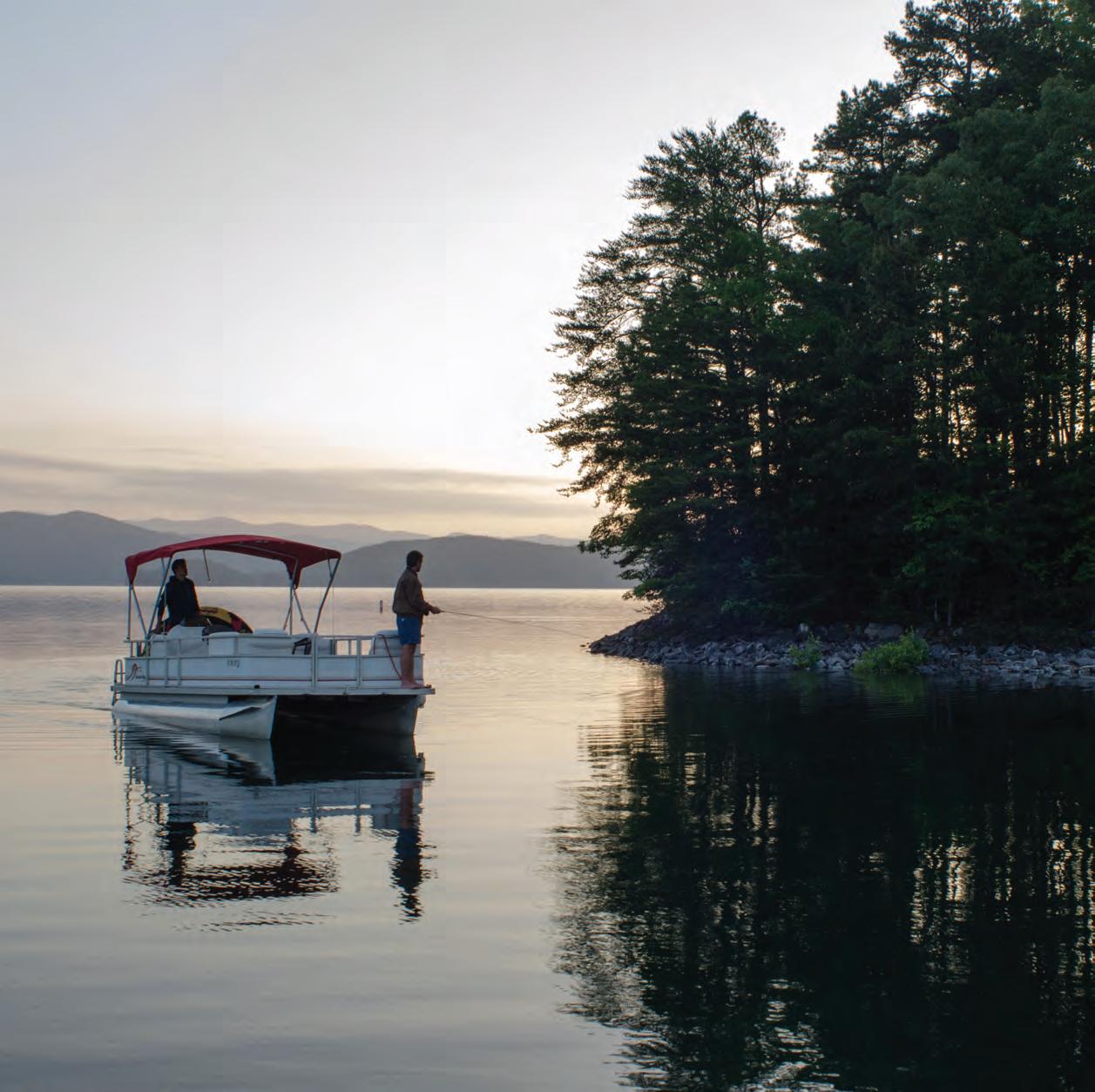



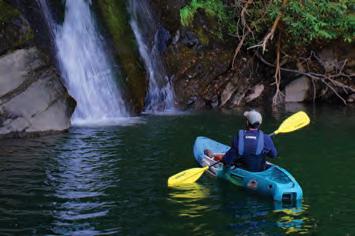

Boat Fix, a recreational boating telematics company that provides a combination of real time remote monitoring, GPS tracking, sophisticated geofencing, and 24/7 live customer support, announced today its Admiral Club Member sponsorship of the National Safe Boating Council (NSBC).
“At Boat Fix, safety is in our DNA and our goal is to promote safe, secure, and stress-free boating,” said Steve Pitsos, CEO, Boat Fix. “To support the NSBC at this level aligns with this vision. We are excited to be a part of the organization and thrilled to help them in their mission of advocating for a safer boating culture.”

“We are very grateful for the support of companies like Boat Fix,” said Peg Phillips, Executive Director, National Safe Boating Council. “Promoting safe boating takes constant education and outreach to the boating community. Only through the support of likeminded companies can we accomplish this vital mission.”
Boat Fix is more than a fleet management
and monitoring solution. As a tool for safer boating and boat ownership, the Boat Fix app sends real time weather alerts and small craft advisories including wave height, visibility, and wind speeds based on the boat’s location; offers geofence protection; safety checklists of U.S. Coast Guard required equipment including calendar reminders with fire extinguishers and flare expiration dates and helps ensure that the correct number of life jackets are on board to be worn; pre- and post-departure checklists to help verify all systems are functioning
properly; as well as remote monitoring of battery voltage – including ultralow, low- and high-voltage which is critical for preventing degradation of battery life and avoiding potential fires or explosions. In addition, the Boat Fix app provides advanced navigation with NOAA charts with detailed navigation marks and depths, rather than industrystandard Google Earth maps.
Users of the Boat Fix Pro app can communicate with the 24/7 Boat Fix team at the touch of a button, through voice, text, email, or two-way video chat to answer questions and diagnose issues on the water. Every call is answered in seconds, in person, by trained professionals ready and willing to help. The industry-exclusive 24/7 Emergency Mechanical Helpline ensures boaters have immediate mechanical assistance over the phone if issues occur on the water.
The 24/7 Boat Fix Control Center also monitors unauthorized use and boat-theft prevention and can share your boat’s exact location with law enforcement.
Founded in 1958, the National Safe Boating Council serves as a national catalyst for developing a safe boating culture by providing educational resources, outreach programming, and training opportunities for industry partners and the boating community to influence fun, safe, and responsible boating.



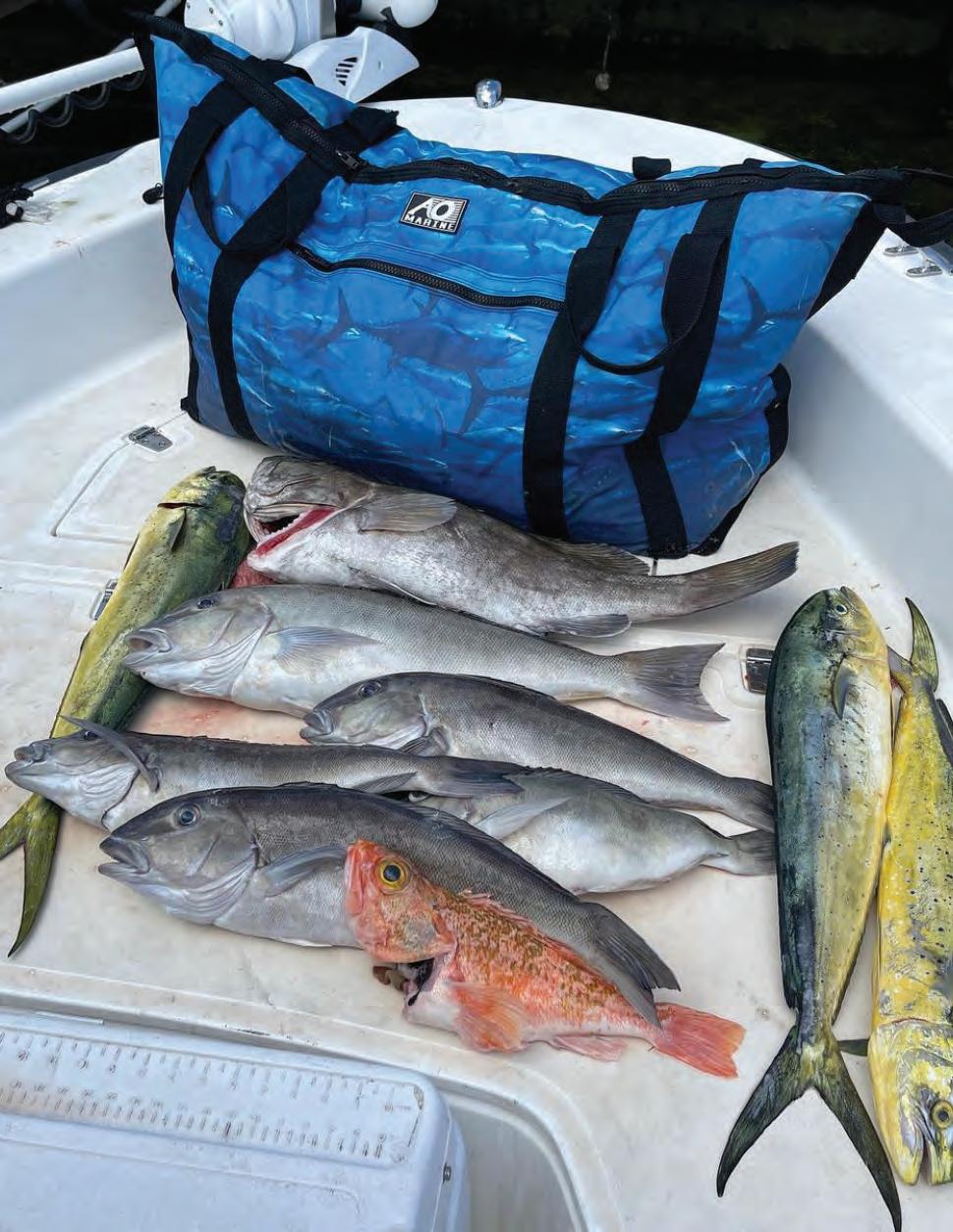






, the leader in high-performance soft-sided coolers, is hitting the water this year with new, upgraded fishing products. Our fishing team partners told us what they needed, and we listened!
Products are in stock and ready to ship; The Fishing Cooler Backpack, 2, 4 & 6ft Fish bags, Fillet bags, Boat fenders, EVA Traction pads, Inflatable Docks, ISUPs, and of course, our high-performance coolers specifically designed for use on boats, guaranteed not to leak, and to keep ice cold for up to 24 hours.
Thirty years ago, AO was launched to provide active, hard-core people with quality products at a reasonable price. We started selling our soft-sided coolers to the hard-core, go-fast boaters and fishermen in Lake Havasu. We aimed to keep ice in our coolers for up to 24 hours in 120-degree Havasu heat. That goal was accomplished 30 years ago, and we’re still at it.
We know our customers; they fish and boat in the summer and ride the dunes or trails in the winter. AO products give those high-octane souls greater freedom to embark on and enjoy what’s important to them.
Make sure that your gear does not hold you back from doing what you love. AO products are built to handle whatever offshore adventure is coming next.
AO is flexibly rugged, seriously fun, and honestly real!
We’re looking for active, adventurous folks that demand quality and performance from their gear. Share your adventure and send us your fish story or photo.

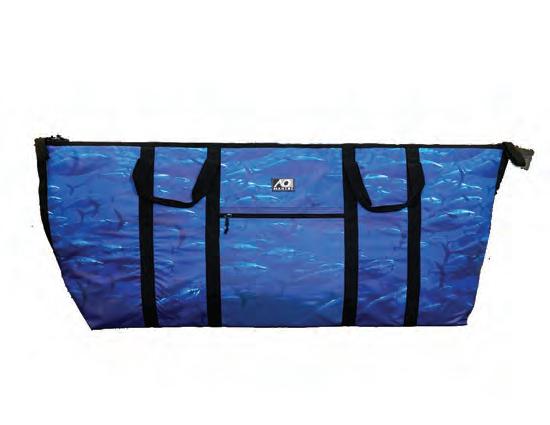










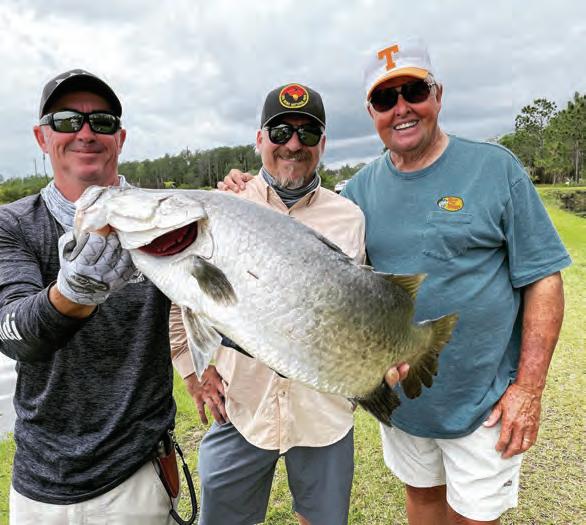

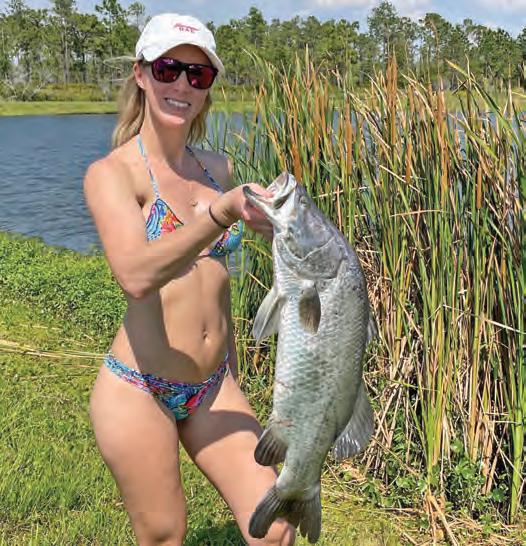


If you’re an avid angler seeking a one-of-a-kind fishing adventure, look no further than Osceola Outback Adventures. Located in Central Florida, just 45 minutes from the Orlando airport, Disney, and other attractions, this full-time guide service offers some of the Sunshine State’s most unique fishing experiences.
At Osceola Outback, you can embark on an unforgettable barramundi fishing expedition. What makes this experience truly special? Well, Osceola Outback is the first and only Barramundi guide service in North America. Native to Australia and weighing as much as 100 pounds, barramundi are hard-hitting, drag-screaming fighters that love to leap out of the water to display their power. The property is a working farm, ensuring that no angler goes home without hooking up multiple times. It’s a rare opportunity to catch these impressive fish!
Florida is a go-to state for bowfishing, thanks to its warm climate and abundant “non-game” fish. Osceola Outback offers both daytime and nighttime bowfishing trips. You’ll have the chance to shoot tilapia, gar, bowfin, and catfish in the state’s extensive network of lakes, ponds, and rivers.
Airboat Bass Fishing: Explore Uncharted Waters
For an adrenaline-pumping experience, try airboat bass

fishing. Osceola Outback’s custom-built airboats are equipped with 8-foot Blade Power-poles, trolling motors, and full walkaround fishing decks. With seating for three anglers and 500-horsepower motors, these boats can take you to places you’ve never explored before. It’s common for two anglers to land 60+ bass in a single 4-hour trip. Keep an eye out for alligators, wading birds, and birds of prey!
Known worldwide for huge stringers of largemouth bass, the Kissimmee Chain of Lakes offers fantastic fishing opportunities. Osceola Outback provides fully rigged bass boats, and their captains are United States Coast Guard certified and licensed. You can choose between fishing with artificial lures or locally caught live wild shiners.
Here’s something truly unique: Osceola Outback is the only place in the world where anglers can land an International Inshore Slam. This prestigious achievement consists of catching barramundi, peacock bass, and largemouth bass all in one location. With barramundi native to Australia and weighing up to 100 pounds, this is an angler’s dream come true.
Whether you’re a seasoned angler or a first-timer, Osceola Outback Adventures promises unforgettable fishing experiences. So grab your gear, cast your line, and get ready for an adventure like no other!

Hilton’s innovative SAT2NAV system connects your Garmin, Furuno or Raymarine chart plotters to HiltonsOffshore. com’s server directly from your MFD. Customize/download the latest dynamic charts and then navigate on them outside of cell range — ALL FROM YOUR MFD SCREEN!
Split screen a Hilton’s chlorophyll or sea temp chart along with a bathymetry chart and/or instrumentation.



Since 2004, Hilton’s has helped serious offshore anglers catch more fish while burning less gas. This is the company that pioneered online satellite fish forecasting with timely updated charts that display all of the pertinent fishfinding information at a reasonable cost for the best anglers in the world.
This year, Hilton’s pushed the industry forward again with its SAT2NAV system. In a quantum leap ahead of any other service in the industry, Hilton’s has brought its unparalleled charts where they belong… to your boat’s chart plotter screen!
Gone are the days when a separate smart device was required to navigate on charts downloaded while in cell phone range. SAT2NAV allows you to surf Hilton’s online mapping portal, select desired charts and then navigate on them—all on the water and all from the multifunction display in your cockpit. Nobody in the industry can do what Hilton’s is doing with SAT2NAV.
SAT2NAV is an external device that connects to the monitors of your Garmin, Raymarine or Furuno multifunction displays. It has its own WIFI and GPS antennas and brings access to Hilton’s charts to the monitors at your helm. It is now possible view your vessel’s position relative to temperature breaks, color changes, high-res bathymetry, altimetry, etc. on your multifunction display.
With split-screen, all of this powerful imagery can be displayed alongside sonar, radar or other desired information.
With SAT2NAV, it’s never been easier to identify and navigate to ocean features where bait and gamefish congregate. You can do your homework on the charts at home, but sometimes it’s necessary to call an audible on the water. With Hilton’s charts clearly visible on your monitor, you can find those good currents, minute temperature changes, sea-surface upwellings, color breaks and navigate to them. Perhaps more importantly, you can eliminate dead water, which makes you a much more efficient and effective angler.

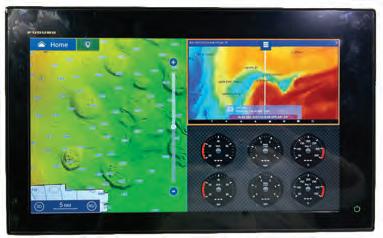
Of course, all of this comes with Hilton’s unrivaled service. Their philosophy, reputation and longevity in the industry rely on the concept that if the information doesn’t help you catch fish, you won’t use it. So, they continually strive to provide the best up-to-date imagery, information and technology, and they’ll go above and beyond to make sure you know what you’re looking at and how to use it.
Hilton’s, again, is leading the industry. With SAT2NAV they can do what no one else in the industry can do right now. At the same time, they are continually working to be better with additional eye-opening features that will further distinguish Hilton’s as the best in the fish forecasting industry. Stay tuned…
Coastal Angler Magazine and its freshwater component The Angler Magazine continue to experience franchise growth. Recent additions to the franchise expansion include Middle Tennessee, Puerto Rico and St. Augustine, Fla. According to CEO Ben Martin, the franchise model is the strongest business platform available in today’s publishing space.
“We’ve just expanded into the Texas
market, and we look for accelerated growth throughout the region,” said Martin. “Coastal Angler and The Angler Magazines boast dozens of current locations, and these new editions add to our powerful and expanding footprint.”
The franchise publishing model acts as a co-op entity enabling franchise owners to enjoy lower costs on printing and other business purchases. Its training program and support system empower
individuals with no prior publishing experience to launch and operate successful local fishing magazines in nearly any market where fishing is a popular pastime.
First published in 1996, Coastal Angler embarked on the franchise model in 2008. The total circulation for the magazine is now over 250,000 copies per month, and it is recognized as the largest outdoor publication in the country.
Mark Twain said it best when he said, “The secret of success is making your vocation your vacation.”


Ken Volbrecht resides in League City, Texas, where he has worked in the recreational boating business for the past 34 years. Over the decades, Ken has acquired certifications such as a factory Certified Mercury and Mercruiser technician along with a Certified Marina Manager. Currently Ken operates two Freedom Boat Club franchises in the Houston/Galveston region. Ken and his wife, Terri have been together for 33 years, sharing a love for the water and a fondness for their many four-legged companions. Their current pride and joy is Jasper, a half-blind Australian shepherd rescue who shares their enthusiasm for the water. Ken and Terri hope to one day teach Jasper to swim, adding yet another joyous memory to their time on the water.
His latest professional endeavor is co-publishing the Coastal Angler Magazine, Houston/Galveston/Upper Coast edition. Ken is excited about the future growth of the Coastal Angler Magazine network in Texas and looks forward to expanding its presence across multiple markets to serve the fishing community in the Lone Star State.

